
Showcasing the Best of Off-Beaten Destinations
- Abra Province Tourist Spots
- Baguio City
- Mountain Province
- REGION I-ILOCOS REGION
- REGION II- CAGAYAN VALLEY
- REGION III – CENTRAL LUZON
- REGION IVA-CALABARZON
- REGION IVB – MIMAROPA
- REGION V – BICOL REGION
- REGION VI – WESTERN VISAYAS
- REGION VII – CENTRAL VISAYAS
- REGION VIII – EASTERN VISAYAS
- REGION IX – ZAMBOANGA PENINSULA
- REGION X – NORTHERN MINDANAO
- REGION XI- Davao Region
- REGION XIII-CARAGA
- Region XII-SOCCSKSARGEN
- BARMM – Bangsamoro
- Work with Me
- Blogging Resources
- Travel Musings
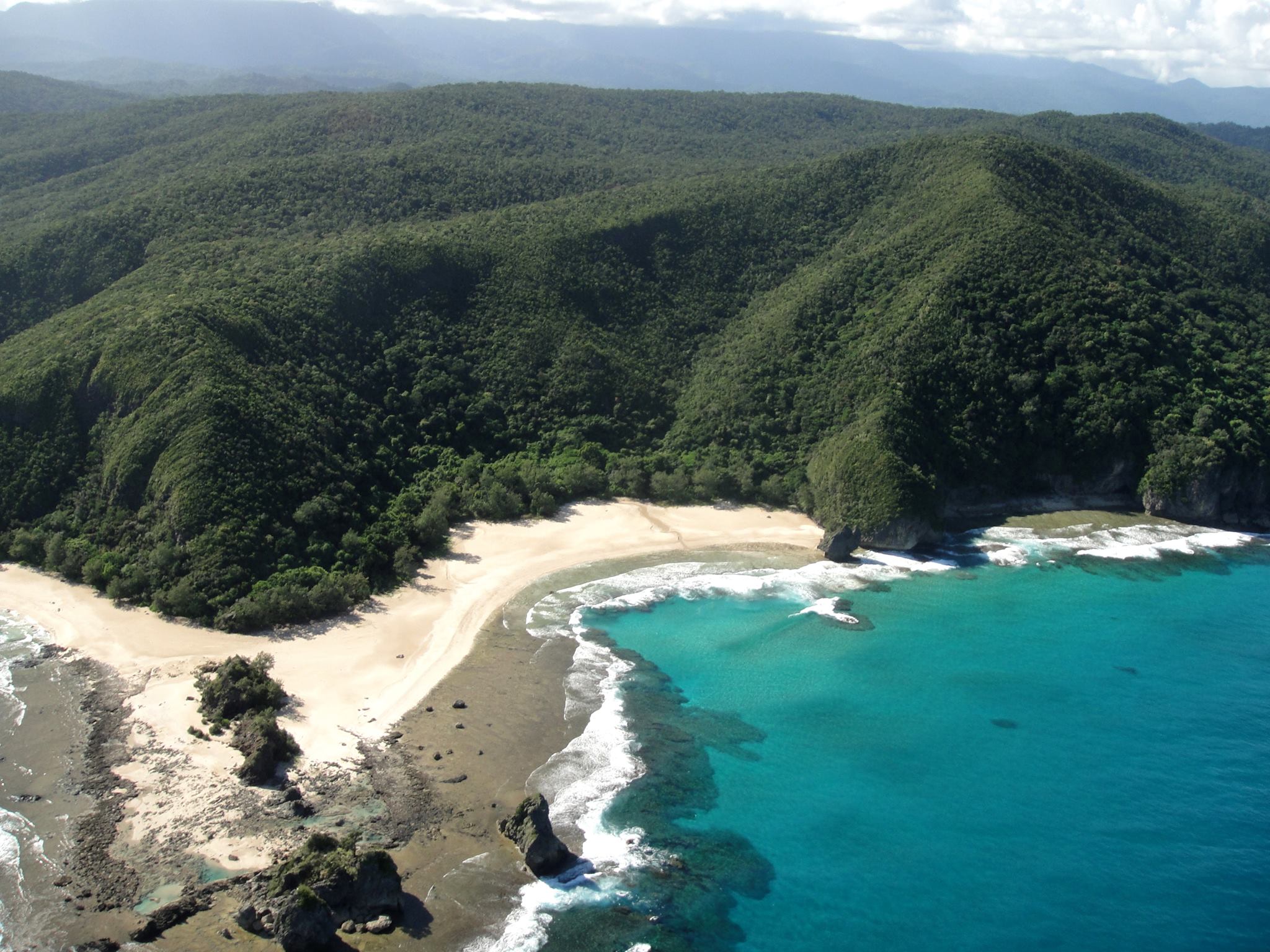

Top 20 Best Isabela Tourist Spots: Nature & Historical Trips
Rustic. Off-beaten. Pristine. Raw. Unspoiled. These are fitting descriptions of the must-see Isabela tourist spots. Explore the natural and historical attractions of this northern province including the best things to do.
Isabela is perhaps more known for its urban attractions such as historical churches and amusement parks. Unknown to many, however, it also hides numerous ecotourism wonders such as cascading waterfalls, pristine forests, and mighty rivers.
As one of the provinces traversed by the Sierra Madre mountain ranger, it comes with countless natural attractions. Many of these remain unknown.
Let’s journey to this northern paradise and unravel some of its fascinating destinations. So where to go in Isabela? Here we go.
Behold Can’t-Miss Isabela Tourist Spots
1. gen. aguinaldo shrine.
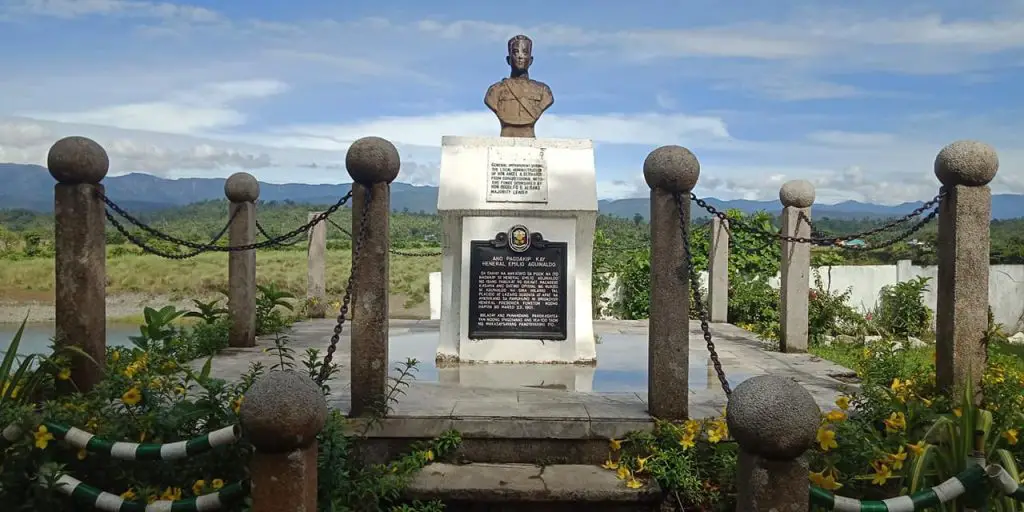
The shrine commemorates the capture of Gen. Emilio Aguinaldo by the invading American forces on March 23, 1901, making it one of the historical tourist spots in Isabela. It is in this province where the general surrendered to the Americans, ending the Filipino-American War
The shrine also offers a breathtaking view of the surrounding landscapes of mountains and verdant rice fields. It’s an ideal spot for unwinding and relishing the surrounding sights.
- Location/Jump-off: Palanan
2. Bonsai Forest

One of the most pristine tourist spots in Isabela, the Bonsai Forest is an enchanting beauty to behold. It covers more than 5000 hectares with plants ranging from one foot to 7 feet. You’ll literally feel like a giant as you walk through this bizarre ecosystem.
The forest also hosts a plethora of flora and fauna species. It’s best to glimpse of the forest while riding a boat towards its narroways. It is one of the most pristine Isabela tourist attractions.
Hiking to these rich mountains will make one experience that time is standing still. Imagine the amazing encounters you’ll have with the diverse ecosystems and just how pristine the place is.
- Location/Jump-off: Brgy Dibulo, Dinapigue
3. Camp Samal
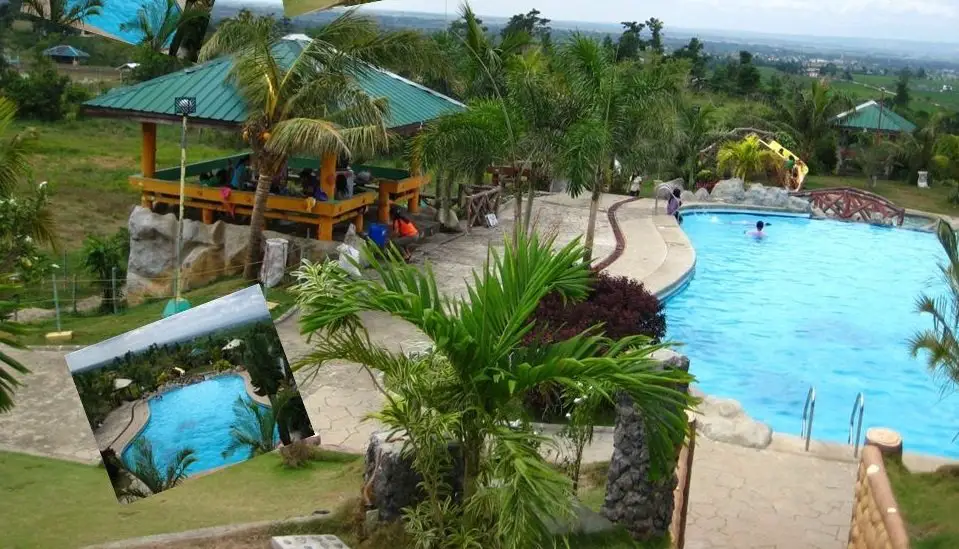
Camp Samal hosted the National Jamboree in 1977. Covering more than 23.50 hectares, it features an elevated mass of rolling hills that are 500 feet above sea level.
From the camp, one can have an overview of the mighty Cagayan River, the Pinacanauan River, the Sierra Madre mountains, and forests including nearby towns and municipalities.
- Location/Jump-off: Tumauini
4. San Mariano Crocodile Sanctuary
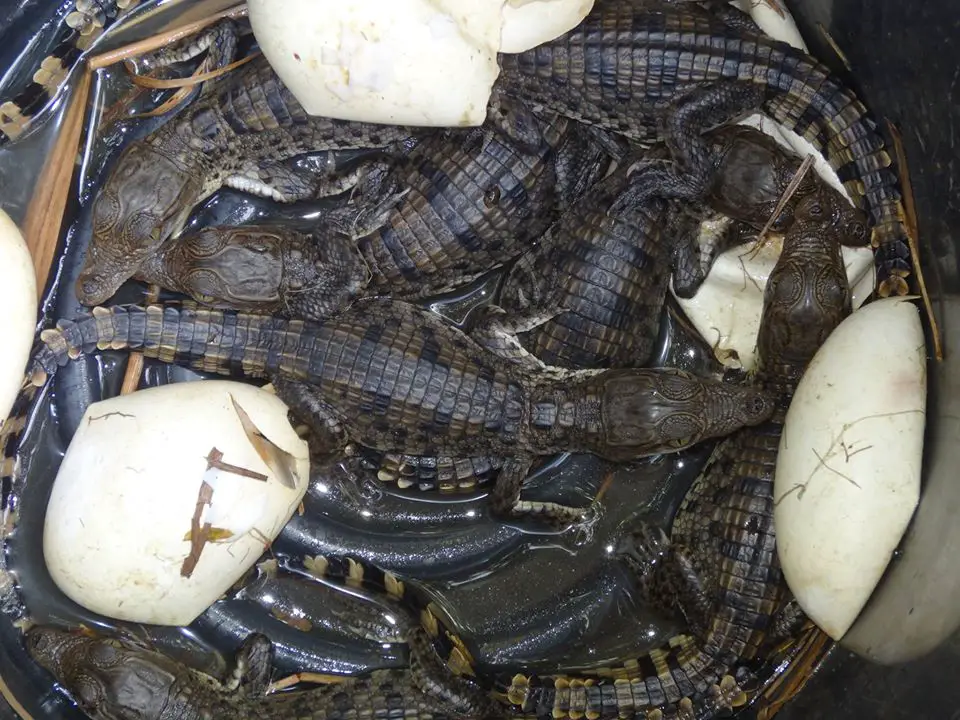
Where to go in Isabela for unique crocodile species? Check out the San Mariano Crocodile Sanctuary.
The river flowing through San Mariano is home to the critically-endangered Philippine Crocodile. To protect the species from extinction, the Mabuwaya foundation and the local authorities created a sanctuary. Visiting it, therefore, contributes to the conservation of these species.
Local authorities share that there are only dozens of Philippine Crocodiles left in the wild. Thanks to this sanctuary and community-based conservation efforts, these gentle creatures are slowly recovering.
- Location/Jump-off: San Mariano
5. Dibulo Falls
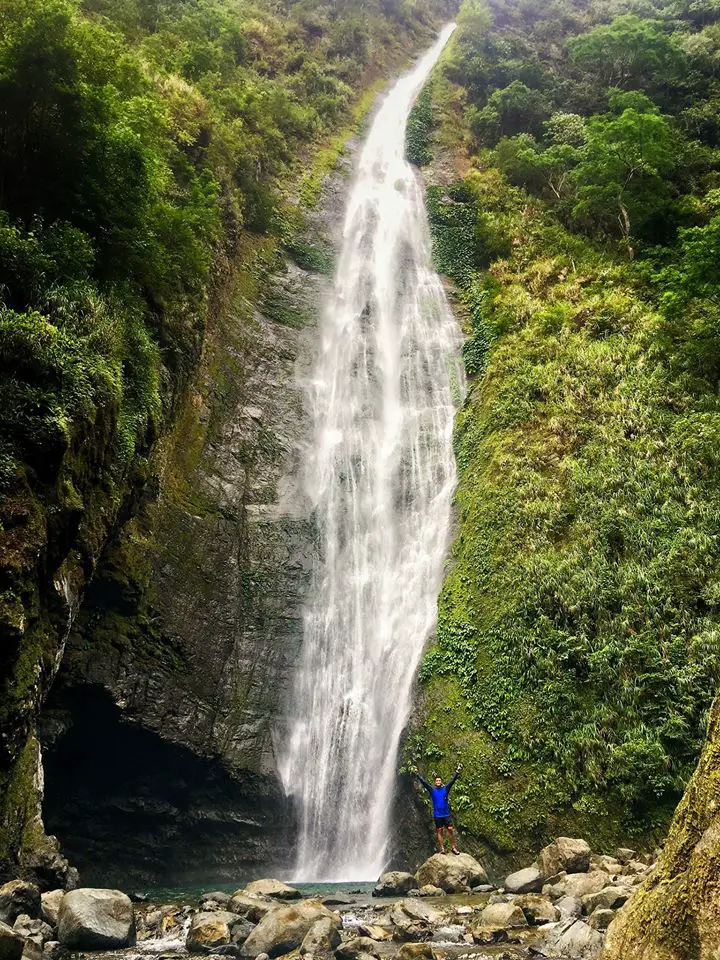
Dibulo falls is one of the remotest tourist spots in Isabela. But for extreme adventurers, hikers, and nature lovers, it is a must-see destination.
The waterfall has three layers and it’s last drop measures more than 100 meters. It carved a small pool with crystal-clear and icy-cold waters which come from dense forests upstream.
Try jumping from one of the surrounding rocks and experience a rejuvenating swim. It’s best to come here during the summer months to enjoy the beauty of the falls.
- Trekking Time: 15-20 minutes
6. Dicotcotan Beach

Dicotcotan beach features a three-kilometer long of pristine beach. It is a perfect getaway for those who prefer less touristy destinations.
Adding beauty to the beach are coral reefs, dense forests, and sea grass beds. From time to time, tourists can glimpse of pointed nose dolphins and hump back whales.
Because the beach lies on a remote destination, few tourists and locals come here. Ah, what an ideal getaway from the bustles and hustles of urban living. Enjoy a stroll on the sandy shore.
Swim on the calm waters. Or take Instagrammable shots of the mystical limestone rock formations.
- Location/Jump-off: Brgy Culasi, Palanan
7. Fuyot Springs National Park
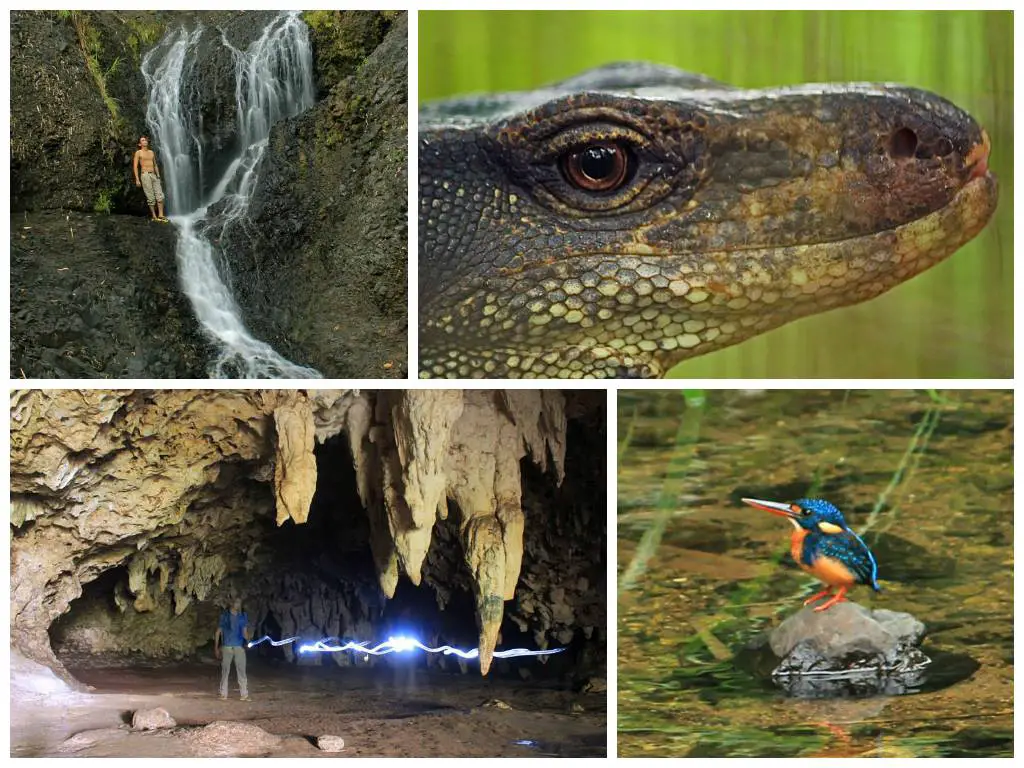
Lying on the foot of the great Sierra Madre wilderness, Fuyot Springs National Park teems with various natural wonders. It is one of the natural-based Ilagan, Isabela tourist spots.
Among the sights to see here are the Sta. Victoria Caves composed of 12 caves with stunning lattices, stalactites, and stalagmites. Then there is the charming Pinzal falls with its elegant cascade and catchbasin.
As you follow the brook upstream, you’ll come across beautiful rocks and waterholes fit for an adventurous spirit.
- Location/Jump-off: Brgy Santa Victoria, Ilagan
- Entrance fee: Php 100
8. Giant Butaka
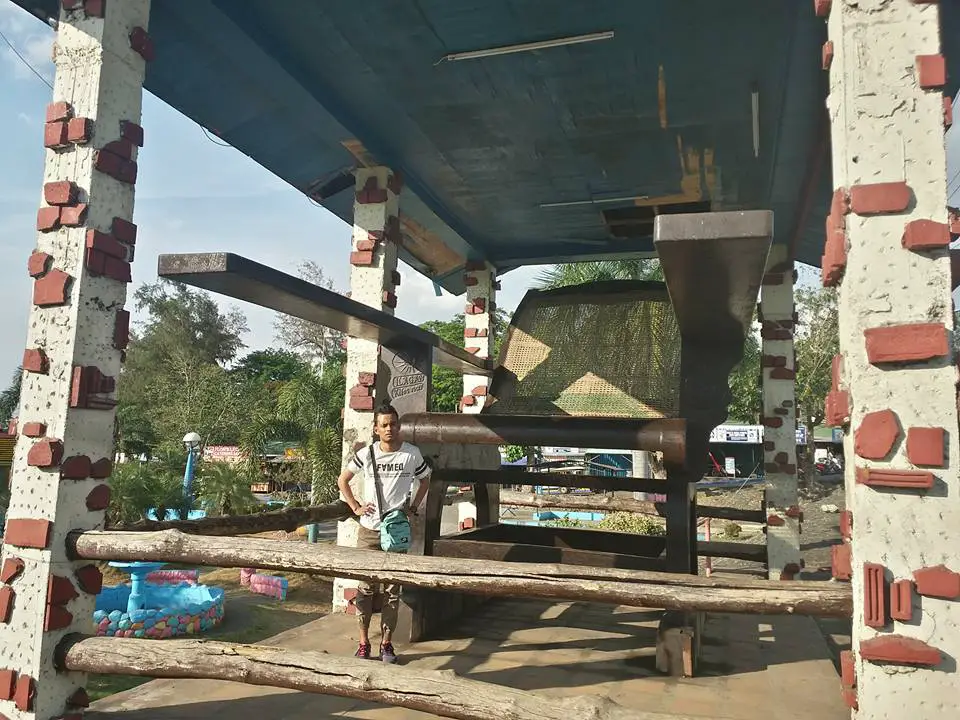
Ilagan City, dubbed as the furniture capital of the province, hosts the world’s largest Butaka with a height at 11 feet, 4 inches high; length of 20 feet, 8 inches; width of 9 feet, 7 inches; and weight of a whopping 2,368 kilos.
Its wide arms represent the genuine hospitality of the locals. Today, it’s one of the iconic tourist spots in Ilagan, Isabela.
- Location/Jump-off: Ilagan City
9. Honeymoon Island
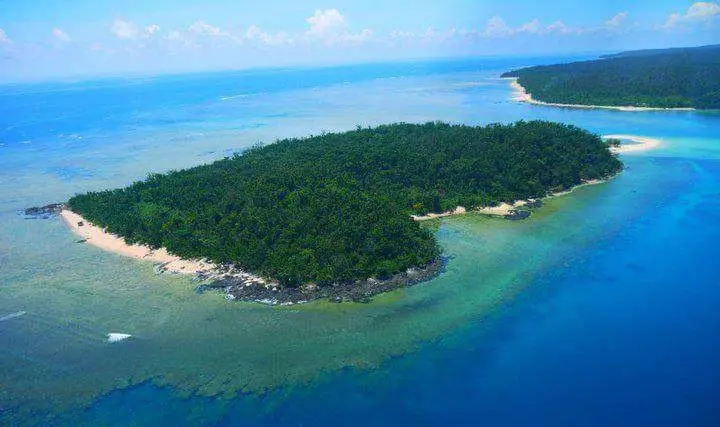
Honeymoon Island is one of the iconic tourist attractions in Isabela, renowned internationally for its white beaches, coastal forests, and rich marine life.
Located in a secluded part of the Pacific Ocean, the island is a favorite getaway for those wanting to experience a rustic ambiance. The island makes up to a perfect side trip when visiting Cauyan, Isabela tourist spots.
- Location/Jump-off: Divilacan
10. Divilacan Mangrove Forest
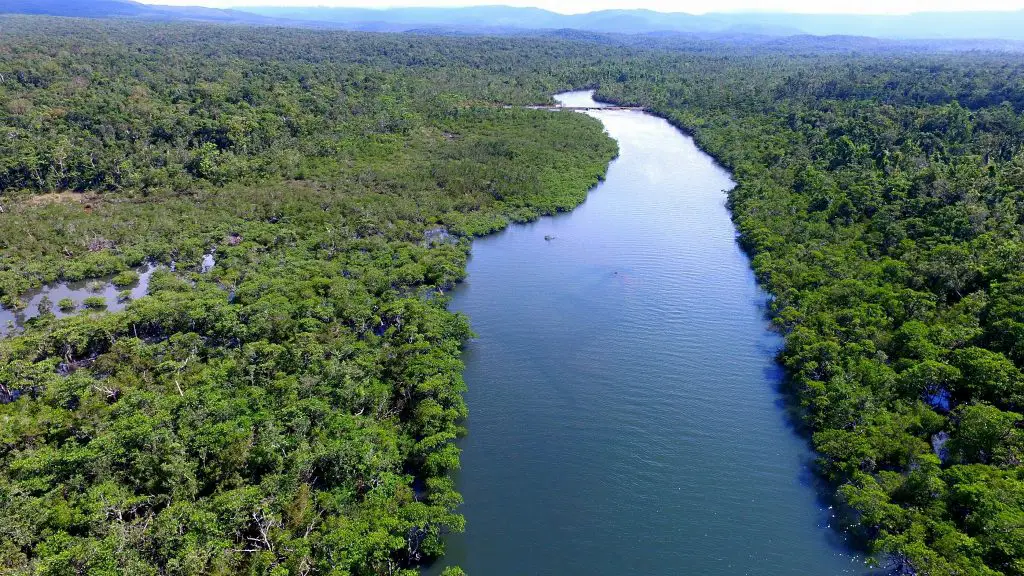
This is one of the important ecological tourist spots in Isabela, owing to the abundance of numerous wildlife species. Imagine navigating the narrow waterways as you glimpse of the floral wonders.
Look down and let the crystal-clear waters blow you away into sheer amazement.
11. Landmark of Heroes
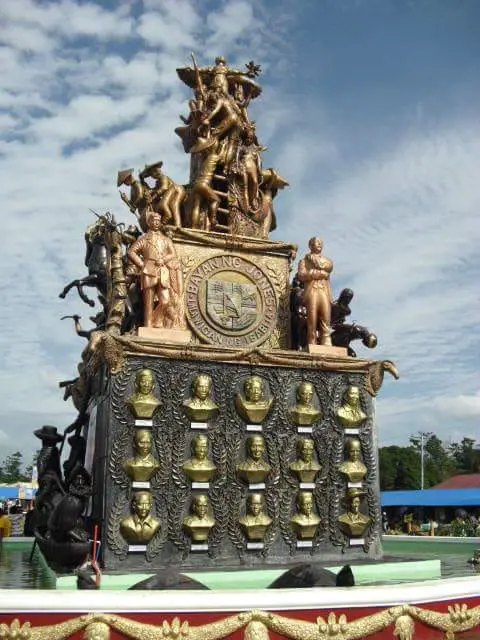
It is one of the recognized historical tourist spots in Isabela. It commemorates Isabela’s forefathers who fought against foreign invasions. Revisit the province’s rich history when you come here and have a glimpse of the bravery and heroism of the people.
- Location/Jump-off: Jones
12. Blue Lagoon

The Blue Lagoon is one of the emerging tourist spots in Isabela. This lake with its inviting waters reflect the blue sky. Boating and swimming are favorite activities here. Jump towards the pool and have a soul-relieving experience.
- Location/Jump-off: Brgy Villa Robles, Palanan
13. Magat Dam

Magat Dam is one of the recognized man-made tourist spots in Isabela and is considered one of the largest dams in Asia. Magat River which emanates from the Cordilleran mountain ranges feeds the dam. Tourists who want to enjoy the Magat Dam’s scenery can stay at Camp Vizcarra.
- Location/Jump-off: Ramon town
14. Mororan River
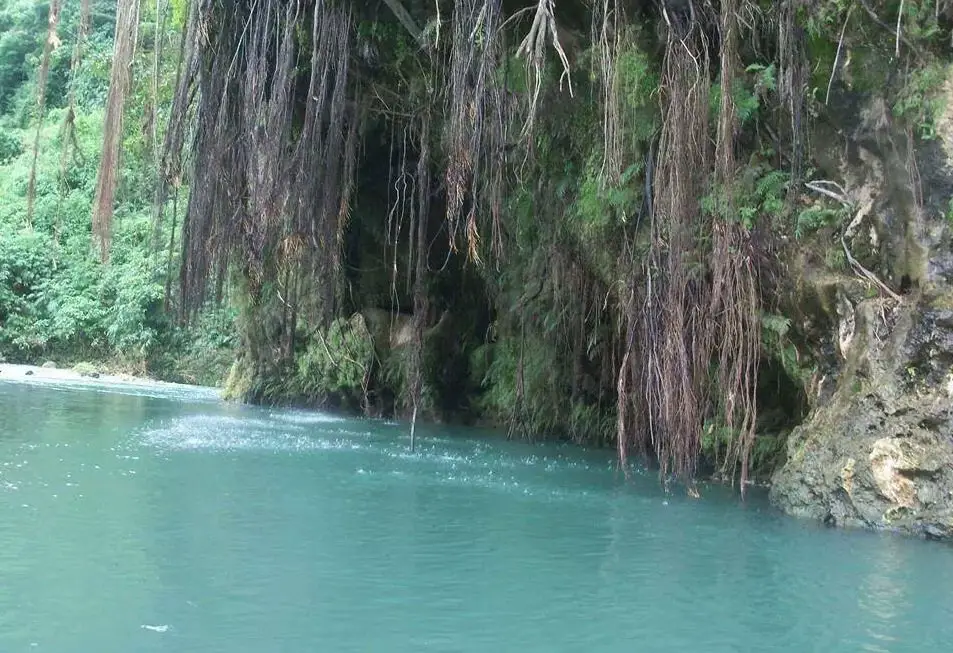
Aside from its crystal-clear waters, the Mororan River features numerous mini-waterfalls along its entire length. Huge boulders add to the scenic view of the river. Locals and travellers alike love coming here to enjoy pure water from the distant forests.
15. Palanan Rainforest

Palanan Rainforest is the Philippine’s largest remaining lowland forest. Today, however, massive logging and commercial farming is shrinking its size and endangering countless species such as the Philippine Eagle.
Ecotourism, if properly developed, could help promote its conservation while boosting local development.
Trekking to the park will lead hikers into the richness of the Philippine forests. Expect to see giant trees, different orchids and wild flowers, and various fauna.
The richness of the forest feeds numerous rivers and brooks, home to endemic fish species. These rivers have deep pockets of pools with enchanting waters that make up for a good swim.
16. Sinavulluan Caves
Sinavulluan Caves feature spectacular stalactite and stalagmite rock formations including enchanting lattices. It is a perfect getaway for avid spelunkers and explorers. It is one of the protected tourist spots in Isabela.
- Location/Jump-off: Brgy Antagan, Tumauini
17. Our Lady of Atocha Church
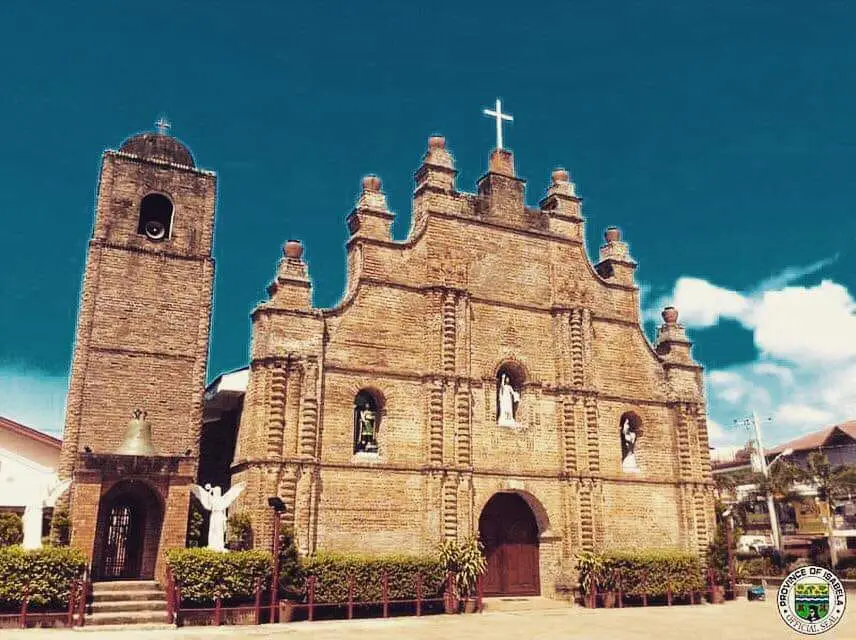
The Our Lady of Atocha Church dates back to the Spanish times and is one of the best known historical tourist spots in Isabela. It boasts of a Castilian architecture. During the Holy Week, thousands of local and foreign pilgrims troop here.
- Location/Jump-off: Alicia
18. Saint Mathias Church
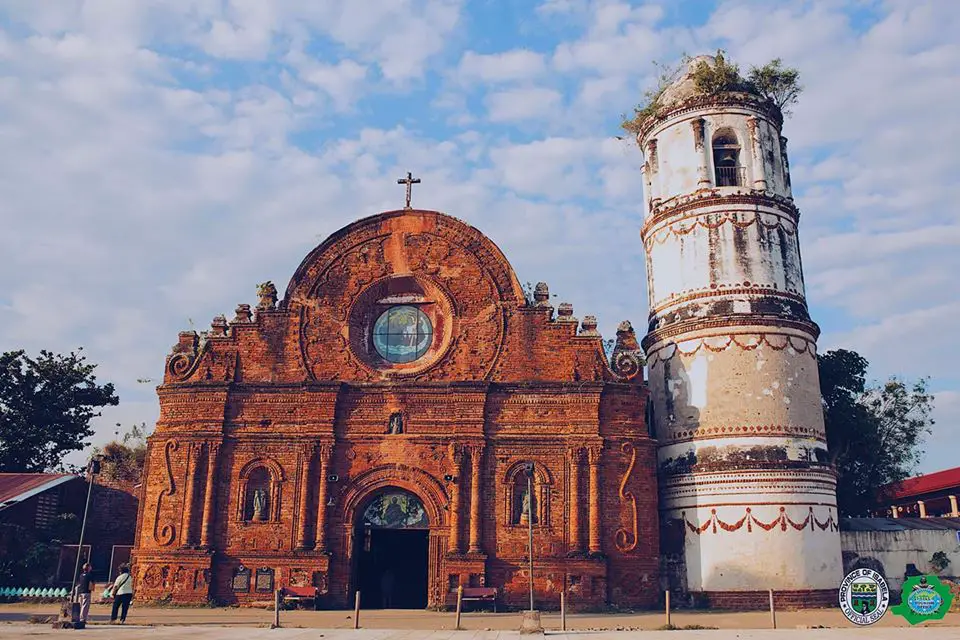
This is one of the many churches found in Isabela with walls made entirely of bricks. It has a four-layered facade which gives the church an imposing view.
Once you’re inside the church, you’ll feel like you are travelling back to the Spanish regime. One could just wonder how the local’s ancestors were able to build such majestic masterpiece.
19. Shrine of Our Lady of La Salette
The chapel sits on the highest point in Santiago City. It is also a major pilgrimage site during the Holy Week, attracting thousands of devout Catholics. It is one of the best Santiago, Isabela tourist spots.
- Location/Jump-off: Santiago City
20. San Pablo Church
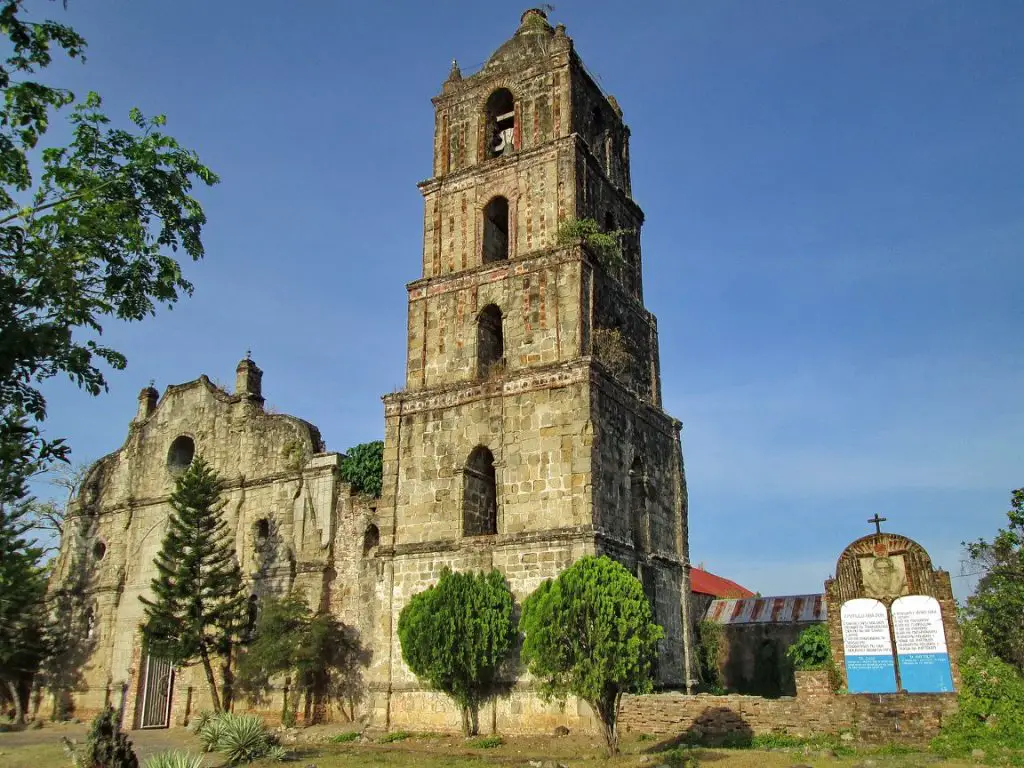
It is considered the oldest church in Isabela. Built in 1624, the church features a six-layered bell tower which is the highest in Cagayan Valley. It is also one of the premium historical tourist spots in Isabela.
Made almost entirely out of bricks, the church continues to attract devotees from all over the province.
- Location/Jump-off: San Pablo
For Your Information
If you need more information to help in setting up your itinerary to the tourist spots in Isabela, do contact the following:
- Email: [email protected]
- Website: http://provinceofisabela.ph/
Related Articles
- 20+ Eco-Tourist Spots in Nueva Vizcaya (Complete DIY Travel Guide)
- 22+ Quirino Tourist Spot (UPDATED): Cascading falls, Rivers , Caves
- Top 20 Cagayan Valley Tourist Spots and Things to Do 2020
Share this:
Leave a comment cancel.
Your email address will not be published. Required fields are marked *
Email Address *
Save my name, email, and website in this browser for the next time I comment.
Hi there fellow traveler! My name is Daniel although you can call me Kumafor. That's my indigenous name. I grew on a remote village called Lias in Barlig, Mountain Province.
Check Out our Latest Posts
- Top 18 Romblon Tourist Spots including natural attractions
- Top 14 Siquijor Tourist Spots: Island of Enchantment
- 19 Top Cebu Tourist Spots and Best Things to Do
- Top 20 Siargao Tourist Spots: Home of Waves and Beaches
- Best 22 Bohol Tourist Spots including the Things to do


10 Amazing Things to Do in Santiago Isabela

So you’re planning a trip to Santiago Isabela and you’re looking for some amazing things to do? Well, you’re in luck! This article is going to give you a list of 10 incredible activities that will make your visit to Santiago Isabela truly unforgettable.
From exploring stunning natural wonders to indulging in delicious local cuisine, there’s something for everyone in this vibrant city. So get ready to discover the hidden gems of Santiago Isabela and make the most out of your time in this enchanting destination.
Table of Contents
Explore the St. James the Apostle Parish Church
Santiago Isabela is home to the beautiful St. James the Apostle Parish Church, and it is a must-visit attraction for anyone exploring the city. The church’s stunning façade immediately catches your eye as you approach it. The intricate architectural details and intricate carvings tell stories of the church’s history and the faith of the community.
Step inside the church, and you’ll be mesmerized by the intricate interior design. The high ceilings, ornate altars, and beautifully painted frescoes create a truly breathtaking atmosphere. Take the time to appreciate the attention to detail in every corner of the church. Whether you’re a person of faith or not, you can’t help but be amazed by the craftsmanship and artistry on display.
If you’re lucky enough to be in Santiago Isabela during a mass or religious ceremony, make sure to attend. The church comes alive with the sound of prayers and hymns, creating a deeply spiritual experience. Even if you don’t understand the language, the sense of community and devotion is palpable.
While you’re at the St. James the Apostle Parish Church, take the opportunity to learn about its history. The church has been a significant part of Santiago Isabela’s heritage for many years, and understanding its past gives you a deeper appreciation for its present. Talk to the locals or the church staff to get snippets of interesting stories and anecdotes about the church’s role in the community.
Go on a food trip in Santiago Isabela
One of the best ways to experience the culture of Santiago Isabela is through its local delicacies. Start your culinary adventure by trying tupig and dudol. Tupig is a sticky rice cake grilled on a banana leaf, giving it a unique smoky flavor. The combination of sweet and savory in each bite is absolutely delicious. Dudol, on the other hand, is a sweet rice cake made with coconut milk. Its creamy texture and subtle sweetness are a delightful treat.
If you’re looking for more substantial meals, head to the local restaurants in Santiago Isabela. They offer a variety of dishes that showcase the flavors and ingredients of the region. Don’t be afraid to try something new and unfamiliar. From traditional Filipino dishes to fusion cuisine, there’s something to satisfy every palate.
To truly immerse yourself in the local food scene, visit the local market for fresh produce. Here, you’ll find an abundance of fruits, vegetables, meats, and seafood all locally sourced and bursting with flavor. Interact with the vendors and ask for their recommendations. They may even share some cooking tips or recipes with you. For a truly unique culinary experience, try your hand at cooking a traditional Filipino dish using the fresh ingredients you find at the market.
No food trip is complete without a good cup of coffee. Head to one of the local cafes in Santiago Isabela and indulge in a cup of freshly brewed coffee. Take a moment to relax, soak in the ambiance, and savor every sip. The aroma and taste of the coffee will invigorate you for the rest of your adventures in Santiago Isabela.
Discover the beauty of Callao Cave
If you’re a nature lover, a visit to Callao Cave is a must. Located just a short boat ride away from Santiago Isabela, this cave is known for its stunning limestone formations and rich history. As you make your way to the cave entrance, enjoy the boat ride and take in the breathtaking views of the surrounding landscape.
Once inside the cave, you’ll be amazed by the beauty of the limestone formations. Stalactites and stalagmites hang from the ceiling and rise from the floor, creating a magical atmosphere. The play of light and shadows adds to the enchantment of the cave. Take your time to explore and appreciate the natural wonders that have been forming for thousands of years.
As you explore Callao Cave, you’ll also have the opportunity to learn about its rich history and folklore. The cave has served as a shelter for humans and a place of worship for indigenous communities throughout the centuries. Guides will share fascinating stories and legends that are deeply rooted in the culture of Santiago Isabela. Listen attentively and let your imagination transport you to a different time and place.
Don’t forget to capture the memories with some unforgettable photos inside the cave. The unique formations and dramatic lighting make for stunning photo opportunities. Whether you’re an amateur or professional photographer, you’ll be inspired to capture the beauty of Callao Cave from different angles and perspectives.
Take a dip in the Magat Dam
For those seeking outdoor activities and a chance to cool off, a visit to the Magat Dam is a must. The dam offers a wide range of water activities, including swimming, kayaking, and boating. Dive into the refreshing water and let your worries drift away as you soak in the beauty of your surroundings.
As you enjoy the water activities, take a moment to admire the scenic views of the dam. The expansive reservoir surrounded by lush green mountains is a sight to behold. The tranquil atmosphere and serene beauty of the area make it an ideal spot to reconnect with nature.
After a day of swimming and water adventures, having a picnic by the lake or a barbecue is the perfect way to unwind. Find a cozy spot, lay out a blanket, and savor a delicious meal amidst the natural beauty of the Magat Dam. The sound of the water and the fresh air create a serene ambiance that enhances the dining experience.
If fishing or boating is more your style, the Magat Dam offers opportunities for both. Cast your line and try your luck in catching some fish from the abundant waters. Alternatively, rent a boat and navigate the reservoir at your own pace. Enjoy the peace and tranquility as you drift along the water, surrounded by the majestic mountains.
Visit the Santiago City Museum
To gain a deeper understanding of Santiago Isabela’s cultural heritage, a visit to the Santiago City Museum is a must. The museum showcases a collection of historical artifacts that provide insight into the city’s past. From archaeological finds to cultural artifacts, each item tells a story of Santiago Isabela’s rich history.
As you wander through the exhibits, you’ll learn about the local traditions and customs that have shaped the identity of the city. The displays offer a glimpse into the lives of the people who have called Santiago Isabela home throughout the years. Take your time to read the informational panels and immerse yourself in the narratives they present.
To enhance your museum experience, keep an eye out for special events or exhibitions. The Santiago City Museum occasionally hosts art exhibits, performances, and cultural festivals. Check their schedule before your visit to see if there are any events happening during your time in Santiago Isabela. Attending these special events allows you to witness the vibrant cultural scene of the city firsthand.
Experience the thrill of extreme sports at Balay da Blas
For adrenaline junkies and thrill-seekers, a visit to Balay da Blas is a must. This adventure park offers a range of exciting activities that will get your heart racing.
Try ziplining across the scenic landscape and feel the rush of wind as you soar through the air. The panoramic views of Santiago Isabela from above are simply breathtaking. If you’ve never experienced ziplining before, don’t worry – the staff at Balay da Blas will provide all the necessary safety equipment and instructions to ensure your adventure is both thrilling and safe.
For a unique perspective of the surrounding nature, go horseback riding through the trails. The experienced guides will lead you through picturesque paths while you enjoy the tranquility of the countryside. It’s a great way to bond with these majestic animals and reconnect with nature.
If you’re up for more challenges, try the off-road biking adventures. Blaze through rugged terrains and experience the thrill of conquering obstacles along the way. The adrenaline rush combined with the stunning landscapes will leave you with unforgettable memories.
For those looking to test their strength and agility, rock climbing is the ultimate challenge. Ascend towering cliffs and conquer your fears as you navigate the rocky walls. Professional guides will ensure your safety and provide guidance for climbers of all levels.
Explore the Bonsai Forest
For a serene and calming experience, take a trip to the Bonsai Forest. This picturesque destination features a collection of miniature trees meticulously cultivated by bonsai enthusiasts. As you walk through the forest, you’ll be surrounded by the intricate beauty of these living artworks.
Take a moment to admire the different bonsai trees on display. Each one is a testament to the art of bonsai cultivation and the dedication of its caretakers. Learn about the techniques used to shape and maintain these miniature trees, and gain a new appreciation for the patience and skill required to create such masterpieces.
The peaceful atmosphere of the Bonsai Forest makes it the perfect place for a leisurely stroll. Let the soothing ambiance calm your mind and restore your inner peace. The beauty of nature combined with the artistry of bonsai creates a unique and enchanting experience.
If you’re interested in learning more about bonsai, attend workshops or classes offered in the Bonsai Forest. Knowledgeable instructors will guide you through the basics of bonsai cultivation, teaching you the techniques and principles behind this ancient art form. Get your hands dirty as you practice shaping and pruning your own bonsai tree under their expert guidance.
Shop for souvenirs at the Isabela House of Culture
No trip would be complete without finding the perfect souvenirs to take home. Visit the Isabela House of Culture for a wide range of locally made crafts and products. Browse through the various stalls and explore the diverse offerings.
Locally made crafts and artworks are a great way to bring a piece of Santiago Isabela’s culture and heritage back home. Look for intricately woven baskets, hand-carved wooden figurines, and vibrant textiles. Each item tells a story and carries the essence of the region.
If you’re interested in traditional clothing and accessories, the Isabela House of Culture is the place to be. Admire the craftsmanship of the traditional garments and accessories on display. From intricately embroidered dresses to delicately woven accessories, these items showcase the rich cultural heritage of Santiago Isabela.
For unique gifts and mementos, explore the stalls filled with handmade trinkets and souvenirs. Whether it’s a keychain, a magnet, or a piece of artwork, you’ll find something special to commemorate your time in Santiago Isabela.
When you purchase from the Isabela House of Culture, you also support local artisans and businesses. By buying their products, you contribute to the preservation of traditional crafts and allow these talented individuals to continue practicing their craft.
Visit the Provincial Capitol and Park
The Provincial Capitol of Santiago Isabela is not only a seat of governance but also an architectural masterpiece. Admire the beauty of the building as you approach it. The intricate details and grandeur of the structure reflect the city’s importance and heritage.
After admiring the architectural beauty, take the time to relax at the park surrounding the Provincial Capitol. The meticulously landscaped grounds offer a respite from the bustling city streets. Find a bench, sit back, and enjoy the scenery. The park’s serene atmosphere and beautiful gardens create a peaceful oasis in the heart of Santiago Isabela.
Don’t miss the opportunity to take photos at the iconic Capitol facade. The grandeur of the building makes it a popular backdrop for both locals and tourists. Capture the memories of your visit with stunning photos that showcase the beauty of Santiago Isabela.
While at the Provincial Capitol, take the chance to learn about the governance of Isabela. Look for informational displays or guided tours that provide insight into the workings of the local government. Understanding the governance structure and processes allows you to gain a deeper appreciation for the city and its leaders.
Go on an eco-adventure at Fuyot Springs National Park
For nature enthusiasts and adventure seekers, Fuyot Springs National Park offers an eco-adventure like no other. Start by taking a refreshing dip in the natural spring pools. The cool, crystal-clear water rejuvenates both body and mind, washing away any stress or fatigue.
Explore the lush forest and scenic trails that surround the springs. Follow the pathways and let the beauty of nature unfold before your eyes. Take your time to appreciate the vibrant colors, fragrant scents, and the sound of birds singing in the trees. The gentle rustling of leaves and the soothing flow of streams create a symphony of nature that lulls you into a state of tranquility.
If you’re up for more rugged adventures, consider camping in the park. Set up your tent amidst the natural beauty and spend a night under the stars. The peacefulness of the park at night, away from the city lights, provides a serene setting for a truly immersive outdoor experience.
Alternatively, have a picnic in one of the designated areas. Find a cozy spot, lay out a blanket, and enjoy a delicious meal surrounded by nature. The combination of good food, fresh air, and beautiful surroundings creates a memorable dining experience.
As you explore Fuyot Springs National Park, take the time to observe the diverse flora and fauna that call this place home. Keep an eye out for interesting plants and animals, and appreciate the interconnectedness of the ecosystem. Remember to leave no trace behind and respect the natural environment as you enjoy your eco-adventure.
Similar Posts

Dinagat Island’s Hidden Tourist Gems

Things To Do In Iloilo for a Memorable Trip

10 Exciting Things to Do in Marikina

Top Fun Things To Do In Aurora For All Travelers!
Exploring the wonders of samar: a comprehensive itinerary, exploring general santos: a complete itinerary.
Home About Us Contact Region Cities
Santiago city: history and tourist spot.
Hey, pals! Ever heard of Santiago City in the Philippines? Nah, not that Spanish Santiago, I’m talking about the city in Isabela. This place is a hoot! Picture this: a city bustling with life and overflowing with vibrant culture, all nestled in the heart of idyllic landscapes. Sounds like a dream, right? But that’s Santiago for ya!
In this city, you’ll find a melting pot of tradition and modernity, just like adobo mixed with a sprinkle of K-pop. Imagine strolling through the busy streets, bursting with energy, and in just a few steps, you’re surrounded by lush, green fields and rice terraces. Isn’t that something?
Still not convinced? Picture this: you’re sipping on some sweet, local sugarcane juice, watching the sun set over the sprawling Sierra Madre. Now, tell me, could it get any better than that?
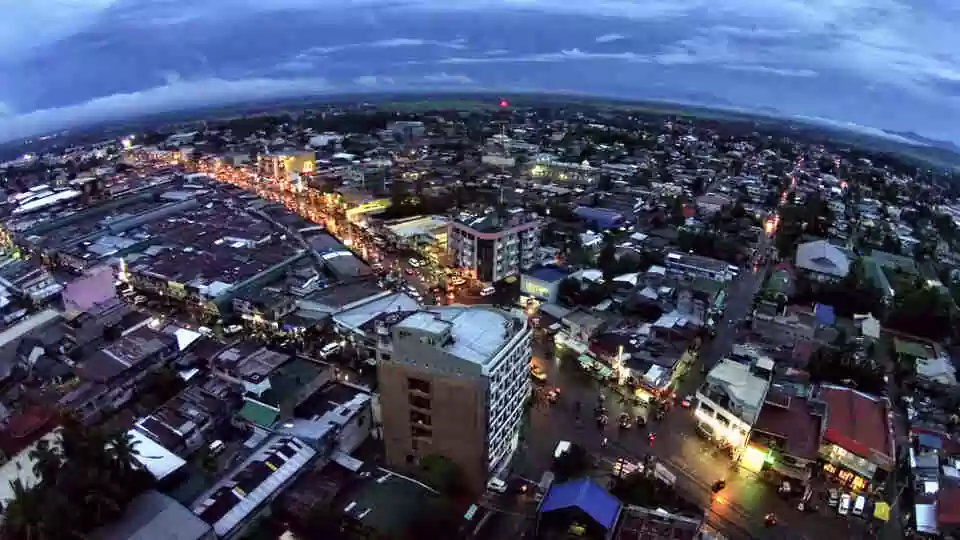
History of Santiago City
Spanish missionaries first founded Santiago City in 1752, setting the foundations for a settlement that would grow and evolve over time. They named the budding town after Saint James the Apostle, the patron saint of Spain.
In the early years, Santiago City was nothing more than a small, remote mission post under the ecclesiastical jurisdiction of the province of Cagayan. It existed as an outpost for the conversion of the indigenous peoples, the Gaddangs, to Christianity.
The late 19th century marked a significant turning point for Santiago City. Due to its strategic location as a gateway to the Cagayan Valley, the town underwent rapid growth. It became a crucial trading post, linking the valley to the rest of the Philippine islands. As a result, more people settled in the area, leading to its recognition as a municipality in 1901 under the American regime.
World War II
Over the next few decades, Santiago City continued to flourish. The city’s economy diversified, with agriculture, trade, and commerce becoming its main industries. The growth and development of Santiago City continued unabated until World War II, which brought destruction and upheaval to the city.
Upon the end of World War II, Santiago City began picking up the pieces. Its citizens worked hard to rebuild their city, displaying a resilience that has come to characterize Santiago City’s history. The city recovered quickly and even experienced a population boom in the post-war years.
The 1990s brought with them a historic moment for Santiago City. On July 4, 1994, the city gained its independence from the province of Isabela. The Philippine Congress passed Republic Act 7720, which converted Santiago into an independent component city. The residents of Santiago voted overwhelmingly in favor of this change during a plebiscite, expressing their desire for greater autonomy.
Today, Santiago City stands as a testament to its rich history and the resilience of its people. It continues to be a bustling center of trade and commerce in the Cagayan Valley, living up to its nickname “Commercial and Trading Center of the North.” From its humble beginnings as a small mission post, Santiago City has grown into one of the most progressive cities in the Philippines.
- A Fusion of Traditions: Santiago City boasts a vibrant cultural scene, combining the traditions of various ethnic groups such as the Ilocanos, Pangasinenses, Yogads, and Kankana-ey. The harmonious blend of these cultures is evident in the city’s festivities, local cuisine, and traditional crafts.
- Festivals that Ignite the Senses: The city comes alive during the Panagdadapun Festival, a colorful celebration held every April. Visitors can witness street dances, and cultural shows, and participate in various activities that showcase the city’s rich heritage and traditions.
- Intriguing Historical Landmarks: History enthusiasts will be captivated by Santiago City’s historical landmarks. The Santiago City Museum and Heritage Center offers a glimpse into the city’s past, housing artifacts, photographs, and exhibits that narrate its history and cultural evolution.
Food Cuisines in Santiago City
Beginning with breakfast, Santiago City’s food journey starts with “kakanin,” a collective term for Filipino rice cakes made from glutinous rice. Puto, a type of steamed rice cake, is often enjoyed with hot cocoa or coffee. The local version of this, Puto Maya, is a must-try, with its unique blend of sticky rice, ginger, and coconut milk.
Moving on to lunch, one encounters the rich and savory dishes that define Filipino cuisine. The “Sinigang na Baboy,” a sour pork soup seasoned with tamarind, tomatoes, and a variety of vegetables, provides a tangy and hearty lunch option. Another local favorite is “Pancit Cabagan,” a noodle dish loaded with pork, vegetables, and quail eggs, named after a nearby town in Isabela. This dish is a testament to the local love for noodles and their Chinese influences.
In the afternoon, Santiago City’s snack scene comes alive. Street vendors line the sidewalks, offering delights like “Banana cue” – skewered bananas coated in caramelized sugar. Another popular snack is “Turon,” another banana-based treat wrapped in spring roll wrappers and fried to a golden crisp.
As dusk falls, the culinary exploration continues with dinner. “Inihaw na Tilapia,” or grilled tilapia, is a favorite, usually served with a dipping sauce of soy sauce and calamansi, a local citrus fruit. Tilapia thrives in the region’s many rivers, making this dish a showcase of local produce. Another dinner staple is “Adobong Manok,” chicken braised in vinegar, soy sauce, garlic, and spices.
Lastly, no culinary journey in Santiago City would be complete without mentioning the famous “Lechon,” a whole roasted pig. Exhibiting crisp, golden skin and tender, flavorful meat, Lechon is often the centerpiece at fiestas and special gatherings. Its rich taste is often accented by “lechon sauce,” made from liver, breadcrumbs, vinegar, and sugar.
Tourist Spots in Santiago City
Start your journey in Santiago City, Isabela with the awe-inspiring Calvary Hills . These hills stretch out over 11 hectares, holding 14 life-sized Stations of the Cross that lead to a three-story-high Giant Cross. As you walk along the path, you’ll experience the serene atmosphere of the location, which provides a unique spiritual experience.
Next, transition to the La Salette Shrine . This popular pilgrimage site features a beautiful church nestled amid lush greenery. Here, you can attend a mass, explore its tranquil surroundings, or simply enjoy the serene ambiance. The shrine is known for its annual celebration of the Feast of Our Lady of La Salette, which attracts local and foreign tourists.
After a spiritual journey, it’s time to immerse yourself in nature. Head to the Palanan Wilderness Area , one of the last remaining lowland rainforests in the country. Its abundant biodiversity will leave you in awe as you hike through trails, spot rare flora and fauna, and cross the mighty Palanan River. It’s a must-visit for nature lovers and adventure enthusiasts.
More Tourist Spots
Once you’ve satisfied your thirst for adventure, plan a visit to the breathtaking Queen Isabela Park . This park serves as the city’s main hub for social gatherings and public events. Not only does the park invite relaxation with its beautiful landscape and calm environment, but it also showcases an impressive statue of Queen Isabela, paying tribute to the city’s namesake.
For history buffs, make sure to include Balay na Santiago on your itinerary. This museum houses a rich collection of artifacts and memorabilia that reflect the city’s history and culture. As you wander through the various exhibits, you’ll gain a deeper understanding of the local heritage.
Finally, end your journey with a trip to the Santiago City Public Market , where you can taste local delicacies, purchase handmade crafts, and mingle with the locals. This bustling market gives you a true taste of the city’s vibrant culture and lifestyle.
Festivals and Events in Santiago City
- Nature Escapades: Immerse yourself in the stunning natural beauty surrounding Santiago City. Explore the breathtaking Malanoche Peak and enjoy panoramic views of the city and its surroundings. Embark on an adventure to the enchanting Tumauini Church, a UNESCO World Heritage Site, renowned for its unique architectural design.
- Culinary Delights: Indulge in the gastronomic wonders of Santiago City. Sample local delicacies such as the famous Pancit Cabagan, a mouthwatering noodle dish, or try the savory Bagnet, a crispy deep-fried pork specialty. Don’t forget to visit the city’s vibrant public market, where you can find fresh produce and regional delicacies.
- Retail Therapy: Shopaholics will delight in the city’s bustling commercial centers. Santiago City offers various shopping districts, including Robinsons Place Santiago and SM City Santiago, where you can find a wide range of retail outlets, boutiques, and local handicrafts.
How to Get There
- By Air: The nearest airport to Santiago City is Cauayan Airport, located approximately 60 kilometers away. From the airport, you can hire a taxi or take a bus to reach the city center.
- By Land: Santiago City is well-connected via land transportation. Buses and vans regularly ply the route from major cities such as Manila and Baguio City. Travel time from Manila is around 8 to 9 hours, depending on traffic conditions.
- By Private Vehicle: If you prefer the flexibility of driving, Santiago City is accessible via major highways. From Manila, take the North Luzon Expressway (NLEX) and continue onto the Subic-Clark-Tarlac Expressway (SCTEX). Follow the MacArthur Highway until you reach Santiago City.
People Also Read: Tourist Spots in Silay City
So, my friends, that’s Santiago City in a nutshell – an exciting mishmash of city life and nature, tradition and innovation. Isn’t it fascinating how one place can hold so many contrasts, yet still feel like a harmonious symphony? It’s like a perfect blend of a latte – the urban buzz (that’s your coffee) perfectly mixed with the calm serenity of nature (your creamy milk).
Got plans for the weekend? How about taking a whirlwind trip to Santiago City and experiencing this incredible harmony firsthand? And who knows, you might just fall in love with this city, the way I did. After all, who can resist the allure of the city that has it all, right?
Remember, adventures await where you least expect them. So, when’s your next unexpected adventure to Santiago City?
Related Posts
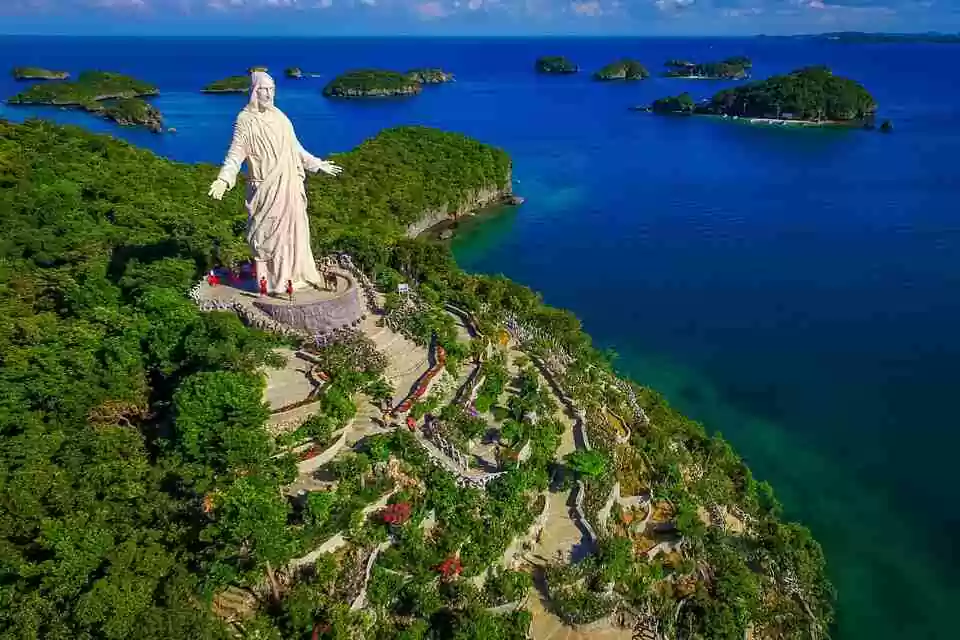
Alaminos City
Alaminos is a coastal city located in the province of Pangasinan in the Philippines. It is known for its natural attractions, including the Hundred Islands…
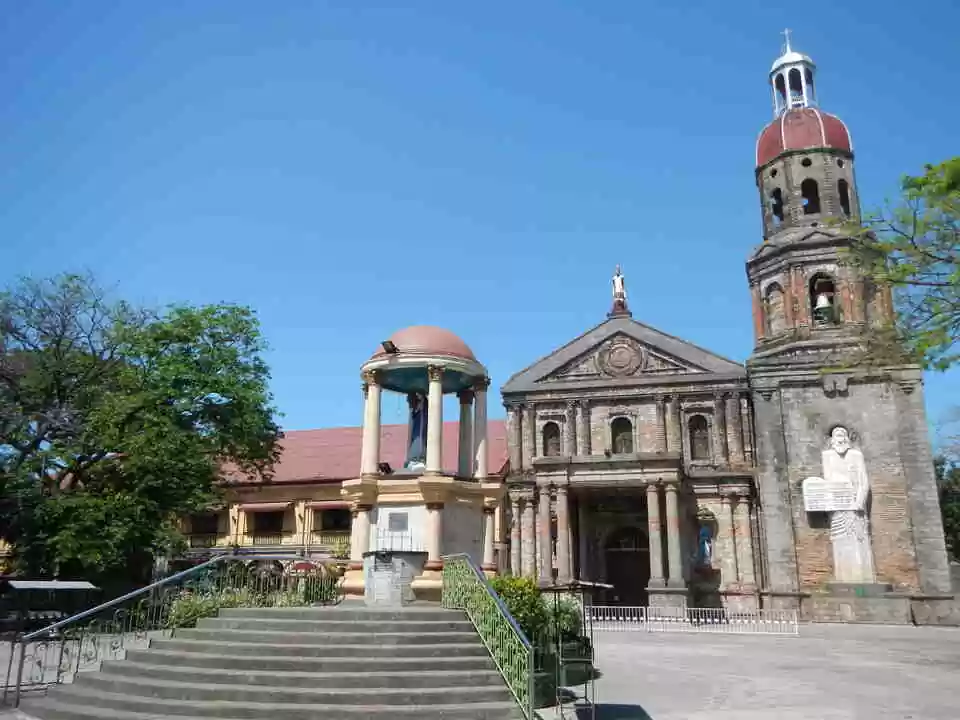
Baliwag City
Baliwag is also known for its delicious cuisine, which is a fusion of Spanish, Chinese, and Filipino flavors. The town's signature dish is the "Lechon…
15 Best ISABELA Tourist Spots (Rice Bowl of the North)
One great way to appreciate the beauty of the Philippines is by exploring its majestic mountain ranges which are filled with hidden gems like enchanting waterfalls, sparkling rivers, beautiful caves, and many more! That’s why visiting Isabela Province, the one and only “Queen Province of the North” is certainly one of the best decisions you could ever make during your memorable adventure in the country. Isabela is popularly known for its rich agriculture industry being hailed as the “Rice Bowl of the North” and the “Top Corn Producer in the Philippines”.
Agriculture is also the reason why Isabela is considered one of the most progressive provinces in the country, with vast natural resources and land territory as well. Another thing you should know is that Isabela is the second-largest province in the whole Philippines, trailing only behind Palawan !
See? Isabela is indeed one of the most underrated tourist destinations in the Philippines. But trust me, an 8-hour long drive from Manila to reach this breathtaking province will absolutely be worth it in the end. I’m sure that once you witness the incredible beauty that the province of Isabela offers to the world, you’ll want to come back over and over again. With the province’s countless natural wonders, rich culture, and beautiful community, Isabela truly is one of the must-visit tourist destinations in the Philippines .
So, what are you waiting for? Come and join me as we both visit and explore the 15 Best Tourist Spots in Isabela!
1. Dibulo Falls
Absolutely one of the best tourist attractions in Isabela is the cascading beauty of Dibulo Falls. This hidden gem located in Dinapigue, Isabela is the tallest waterfall you can find in the province with a towering height of 100 meters. The giant white crystal clear waters cascading down the side of a majestic mountain are truly a magnificent sight worth remembering as well as the beautiful rock formations scattered all around the area. There’s also a huge pool with extremely cold waters where everyone can take a dip and swim all they want!

Photo: TripAdvisor
All in all, Dibulo Falls really is a must-visit destination, especially for outdoor lovers. It offers an all-in experience allowing visitors to be closer to nature than ever.
2. Dicotcotan Beach
If your goal is to find someplace where you can peacefully relax and breathe some fresh air by yourself, then visiting Dicotcotan Beach is undoubtedly the perfect choice. With its white-sand beaches, pristine waters, and well-preserved biodiversity, Isabela’s Dicotcotan Beach is nothing short of a tropical paradise. Take your time to enjoy walking along the 3-kilometer white sand beach as the calm ocean waves rustle down your feet! The beach is relatively isolated which is mainly the reason for its tranquil condition.

Photo: Philippines FB
A lot of people who have been to Dicotcotan said that the beach is teeming with fresh seafood such as Blue Marlins, Blue Dot Lapu-Lapu, and many more. Oh, and there also have been numerous reports of dolphin sightings near the beach! Some even say that you can swim with rare sea turtles or pawikan making your visit here to Dicotcotan Beach extra special.
3. General Aguinaldo Shrine
Known as where the “Last Stand” of President Emilio Aguinaldo took place, the General Aguinaldo Shrine in Palanan, Isabela proves to be a very significant piece of our country’s history specifically regarding the Philippine Revolution.

Photo by Province of Isabela
It is said that this was the very place where Aguinaldo surrendered to the American forces in 1901 marking the end of the revolution. The entire shrine is living memorabilia that commemorates the heroic acts of not only Emilio Aguinaldo but all of the brave Filipino soldiers during the war.
The General Aguinaldo Shrine in itself is a must-visit tourist destination in Isabela because of the scenic sights surrounding the shrine consisting of rugged mountains, lush forests, and colorful skies that are perfect for photo ops!
4. Bonsai Forest
Ah, for all the plantitos and plantitas out there, this next destination will surely bring sparkles to your eyes. The Bonsai Forest of Dinapigue, Isabela is known for showcasing thousands of different kinds of trees and plants ranging from 1 to 7 ft high.

Photo: Tripadvisor
The forest covers an enormous area of 5,000 hectares! Visiting this forest is like traveling to a whole new dimension with unique and even strange-looking trees scattered everywhere. The beauty of Isabela’s Bonsai Forest was also able to impress people from all over the world as it is included in the tentative list of new UNESCO World Heritage Sites.
I suggest that you take your best drone shots during your visit here to Bonsai Forest because the views are absolutely astonishing!
5. Fuyot Springs National Park
Another perfect destination in Isabela for nature-lovers out there is the Fuyot Springs National Park which is located in Ilagan, Isabela. This protected area contains countless natural wonders that attract mountaineers, spelunkers, trekkers, and birdwatchers from different parts of the world!

The park’s caves, beautiful rock formations, and exciting mountain trails are definitely special and will bring you closer than ever to mother nature. The famous Ilagan Sanctuary is also situated inside the park where tons of fun activities are waiting for every visitor. From bird-viewing to visiting the mini-zoo, ATV rides, and butterfly park, I’m sure that you’ll definitely have a blast during your adventure here!
Oh, and don’t forget to drop by and witness the sparkling beauty of Pinzal Falls, which is also located inside the 819-hectare paradise of Fuyot Springs National Park!
6. Magat Dam
One of the most prominent and unique tourist destinations found in Isabela is the mighty Magat Dam. Constructed way back in the early 1980s, the dam was so big that it was considered to be the largest in entire Asia during its time. Up to this day, Magat Dam continues to provide Cagayan Valley with irrigation water and hydroelectric power. The dam in itself is already an engineering wonder worth witnessing and at the same time possesses incredible natural features perfect for outdoor lovers! That’s why aside from its conventional functions, Magat Dam also generates local tourism for the province of Isabela through the Magat Dam Tourism Complex.

The complex is centered on the 4,450-hectare lake formed by the dam where visitors can enjoy fishing, picnicking, and other watersports activities such as boating, water-skiing, and many more! Locals say that the water in Magat Dam is so clear that you’ll be able to catch fresh fish like Biya, tilapia, ayungin, and lots more!
7. Honeymoon Island
Were you intrigued by the name, too? Well, the famous Honeymoon Island of Isabela is indeed the perfect place for beautiful couples out there who are looking for some time alone and away from all the noise of the outside world. The pristine beauty of the white sand beach, the crystal clear waters of the Pacific Ocean, and the lush natural forest surrounding the island are all simply breathtaking and romantic at the same time. The thriving marine biodiversity featuring the abundant aquatic life and coral reefs of the island is also perfect for snorkeling and scuba diving!
Although it takes roughly about 30 minutes of boat ride from the nearest town of Divilacan, Isabela to reach the beautifully isolated Honeymoon Island, I promise that it will all be worth it. So, what are you waiting for? Book a trip here to Honeymoon Island with your special someone!
8. San Pablo de Cabigan Church Ruins
There’s really something about old structures and ruins that make us feel like we’re going back in time, right? They make us feel nostalgic and appreciate our country’s history even more. Well, that’s exactly what the San Pablo de Cabigan Church Ruins of Isabela will make you feel! This church, which was built in 1625 is officially the oldest church in the entire province of Isabela. And what makes San Pablo Church extra special is that it is made of adobe, which is considered to be a very durable building material. Given that it already existed for almost 400 years, the church witnessed some of the most crucial parts of our history from the Spanish Colonial Era, World War II, and even the Martial Law Era.

Photo: Philippine Pride
The ruins in themselves are already a wonderful tourist destination but if you’re a Catholic, I suggest that you take some time to attend the mass here at San Pablo de Cabigan Church Ruins to offer your prayers and wishes.
9. Giant Butaca
For those who don’t know, the Giant Butaca of Isabela is literally a giant version of a traditional Spanish “lazy chair” that actually won the title of the Biggest Armchair in the Guinness Book of World Records. Locally known as Butaca ni Goliath, the giant armchair measures 11.4 ft high, 20.8 ft long, and 9.7 ft wide. It also weighs an astonishing 2,368 kilograms!

Photo: Isabela Aking Probinsya
A proper armchair for a giant indeed, right? The Giant Butaca has long been a popular tourist landmark in Ilagan City where thousands of visitors drop by just to take pictures and admire this beautiful masterpiece. So make sure to visit this enormous rocking chair and not miss out, okay?
READ MORE: Bambanti Festival: A Celebration of Isabela’s Heritage & Harvest
10. St. Matthias Church in Tumauini
The St. Matthias Church or more popularly known as the Tumauini Church is one of the most beautiful and breathtaking religious landmarks not only in Isabela but the whole Philippines. Known by many for its red-bricked Baroque-style architecture, Tumauini Church easily captures the hearts of countless tourists for its incredible beauty.
Photo: Wikimedia Commons
The stunning facade, the iconic bell tower, and the scenic landscape surrounding the church are indeed a remarkable sight you won’t forget. So if I were you, I wouldn’t miss the chance to stop by this iconic church and take some memorable pictures for my Isabela adventure album!
11. Camp Samal
Located in the eastern part of the town of Tumauini, Isabela, Camp Samal is a 23.5-hectare area dedicated to all the activities of the Boy Scouts of the Philippines. The camp consists of its trademark rolling hills along with other incredible natural features like springs, shrubs, trails, and many more.
These are where the routines and training of boy scouts and girl scouts are held so expect to witness some fun and exciting outdoor activities during your visit here! The camp is open for tourists who are interested in exploring the beautiful scenery nestled within as well as the historic memorabilia of the association of the boy scouts and girl scouts.
12. Blue Lagoon in Palanan
The enchanting beauty of Blue Lagoon, the hidden gem of Palanan, Isabela is definitely one of the most beautiful natural wonders you can ever witness in your entire life. With its natural and crystal clear blue waters, you can easily see different kinds of fishes swimming below. The reason why fishes can be seen in this freshwater lagoon is that it is said to be connected to a larger body of water, perhaps the ocean. Although divers and researchers still aren’t able to find this specific connection. So up to this day, it’s still considered a mystery!

Taga Palanan Ako
There are cottages set up around the Blue Lagoon where visitors can leave their things or relax while admiring the captivating beauty of Blue Lagoon. Oh, and the best part is that the Blue Lagoon can be reached via a 20-minute tricycle ride from the Palanan town proper!
13. San Mariano Crocodile Sanctuary
The Philippines is home to a lot of rare and incredible things and one of those is the Philippine Crocodile. This species of crocodile is considered to be the rarest in the world and unfortunately, they also belong to the world’s most endangered animal species. But thankfully, you can still see and admire them in San Mariano Crocodile Sanctuary where experts treat and breed them carefully.

The good thing about organizations like San Mariano is that they also promote the importance of preserving our country’s fantastic natural blessings. So for everyone who’s planning to visit San Mariano Crocodile Sanctuary, let us help each other to protect and love our endangered animal species so future generations can still have a chance to meet them!
14. Queen Isabela Park
And there it is! One of the most amazing facts about the province of Isabela is that it was named after Queen Isabella II of Spain, a prominent figure in Spanish history. And to further honor the roots of the province, the government decided to build a park in her name, the Queen Isabela Park located in Ilagan, Isabela.

Photo: Isabela Bloggers Society
Today, the park also attracts thousands of tourists who visit the province of Isabela where colorful Christmas decorations, exciting festivals, and sparkling bazaars are held all throughout the year. The outdoor stadium also has the capacity to hold more than 10,000 people!
For tourists, the Queen Isabela Park is a perfect spot to score great deals on souvenirs, delicious delicacies, and even some pasalubongs such as moriecos, tinubong, bibingka, and many more!
15. Landmark of Heroes
Finally, our last but definitely not the least destination for our Isabela adventure is the iconic Landmark of Heroes found in Jones, Isabela. This historical landmark was built to commemorate all of our founding fathers who dedicated their sweat and blood to the freedom of our country. The monument also serves as an important for every Filipino to take care of and protect their freedom. For visiting tourists, the Landmark of Heroes is definitely a must-visit destination in Isabela especially if you’re keen on knowing more about the province’s rich culture and history.
More Isabela Blog Posts
- Meraki Garden: Colorful & A Must-Visit Place in Isabela
- Pancit Cabagan of Isabela
- Mango Suites in Cauayan City, Isabela
More Tourist Spots in the Philippines
- Best Baguio Tourist Spots
- Best Ilocos Norte Tourist Spots
- 15 Best Tourist Spots in Nueva Vizaya
- 15 Best ABRA Tourist Spots (Waterfalls, Caves and More)
- Best Ilocos Sur Tourist Spots
- Bataan Tourist Spots

previous
Top 7 places to explore in Thailand

newer
ILOILO TO CAGAYAN DE ORO by Ferry (Vice Versa with Sched & Rates)
You might also like.

Bambanti Festival 2024: A Celebration of Isabela’s Heritage and Harvest

MANGO SUITES: A Nice Boutique Hotel in Cauayan, Isabela
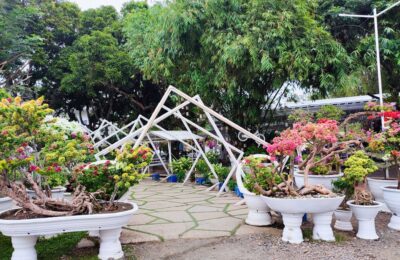
MERAKI GARDEN: Colorful & A Must-Visit Place in Isabela
Leave a reply cancel reply, privacy overview.

- Santiago City, Isabela

Santiago was originally a part of the province Cagayan (comprising the whole Cagayan Valley region), which was reorganized as a political subdivision in 1583 with Nueva Segovia as its capital. It was named after its patron saint St. James the Apostle. On May 1, 1856, when the Province of Isabela was carved out by a Royal Decree, Santiago was among the towns relinquished to the newly created province. The first five barrios after the Cadastral survey in 1927 were Patul, Batal, Nabbuan, Buenavista and Dubinan.
It was said that there were only about three Filipino-owned sari-sari stores in Santiago in 1917. The settlers acquired most of their merchandise and other provisions from Chinese traders in Echague, the landing zone for products intended for Santiago and other towns, owing to its proximity to the Cagayan River.
Santiago continued to progressed until it was converted into an independent component city.
Population/ Language/ Area
The total land area of Santiago City is 275.00 km 2 (106.18 sq mi). The total land area the city is 80% flat or nearly level land in the portions of northwestern, eastern and western parts of the city. While adjacent areas have gently undulating and moderately rolling areas, and the remaining areas constitutes steeply undulating and rolling lands. The Balintocatoc Hills is the highest point in the city. As of 2010, the population recorded was 132,804.
Products and Services
Some of the biggest companies that can be found in the city are Vista Land-Camella Isabela, ABS-CBN, GMA7, San Miguel Corp., Pepsi Cola, Purefoods, Digitel and PLDT. The National Food Authority also maintains its presence in the city, competing with local traders as a strategy to stabilize prices. Different Car companies like Mitsubishi, Toyota, Nissan, Isuzu, Hyundai, General Motors, other car companies as well as Yamaha and Honda Motors maintain their presence in the city. Kia Motors and Ford Mazda are set to open their branches in this city soon.
Santiago also houses some of the biggest and highly equipped hospitals in the region.
Agriculture however is still the main source of livelihood. The main crops are palay, corn, high value fruits and vegetables. The city is where imposing grain stations can be found, buying agricultural crops coming from Ifugao, Kalinga, Quirino, Nueva Viscaya, and parts of Isabela. These crops are later transported either to Nueva Ecija, Bulacan, Pangasinan or Batangas. In addition to the city’s new product is Muscovado sugar. The city aims not only to sell this product locally but also to export the same. Rice mills are also present.
Tourist Spots
- Sunshine Wave Resort and Garden Venue
- Spring Garden Resort and Hotel
- San Andres Country Farm

Explore Santiago City
Plan your trip to santiago city: best of santiago city tourism.

Essential Santiago City
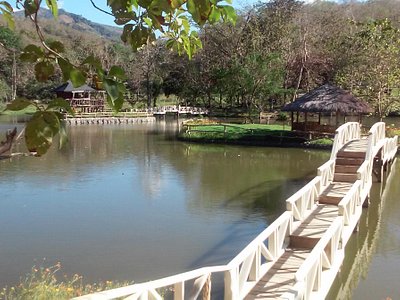
Top 20 Isabela Tourist Spots
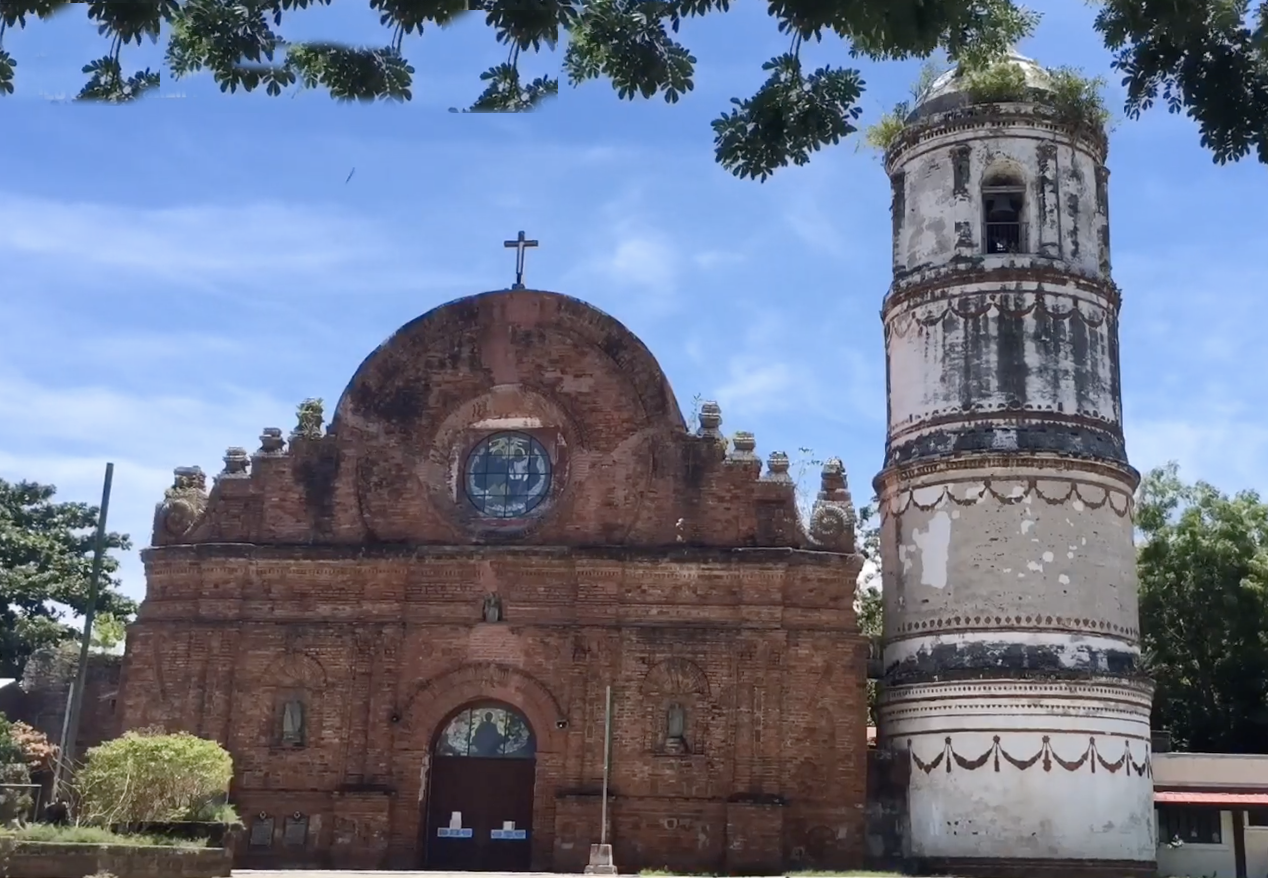
Isabela, the second-largest province in the Philippines, offers a mix of natural beauty, rich history, and vibrant culture. Discover the top 20 Isabela tourist spots that make this destination an unforgettable destination.
1. Northern Sierra Madre Natural Park
This vast protected area is home to diverse flora and fauna, making it a paradise for nature lovers and wildlife enthusiasts.
2. Ilagan Sanctuary
Experience an exciting adventure at this eco-park in Ilagan City, where you can enjoy a zip line, rappelling, trekking, and a cave exploration.
3. Bonsai Forest
Discover the unique and enchanting Bonsai Forest in Dinapigue, where you'll find a variety of dwarf trees in their natural habitat.
4. Queen Isabela Park
Located in Ilagan City, this park is dedicated to Queen Isabela II of Spain and features lush gardens, fountains, and historical monuments.
5. St. Paul the Apostle Parish Church
Visit this centuries-old church in Echague, which boasts a beautiful blend of Baroque and Gothic architecture.
6. Honeymoon Island
Located in Maconacon, this secluded island offers pristine white-sand beaches and crystal-clear waters perfect for swimming and snorkeling.
7. Magat Dam
One of the largest dams in the Philippines, Magat Dam in Ramon provides hydroelectric power and irrigation to the region. It's also a popular fishing spot.
8. Our Lady of the Visitation Church
This historic church in Gamu is known for its beautiful architecture and its miraculous image of Our Lady of the Visitation.
9. Fuyot Spring National Park
Located at the foot of Mount Santa Victoria, this park offers picturesque landscapes, natural springs, and a wide variety of outdoor activities.
10. Crocodile Farm and Wildlife Sanctuary
Learn about Philippine crocodiles and other wildlife at this conservation facility in San Mariano.
11. Abuan River
Experience thrilling white-water rafting and kayaking adventures on the Abuan River in Ilagan.
12. San Pablo Church
Visit one of the oldest churches in Isabela, built in the 17th century and located in the municipality of San Pablo.
13. Balay na Santiago
Explore this ancestral house turned museum in Santiago City, showcasing the rich history and culture of the province.
14. Palanan Wilderness Area
Discover the diverse flora and fauna of this protected area in Palanan, which is also home to the critically endangered Philippine eagle.
15. Dicotcotan Beach
This serene beach in Palanan is perfect for those seeking a relaxing getaway surrounded by nature.
16. Governor Faustino N. Dy Sr. Memorial Park
This park in Ilagan City is dedicated to the late governor and features landscaped gardens, monuments, and a playground for children.
17. Calvary Hills
Located in Gamu, this attraction features life-sized statues depicting the Stations of the Cross, providing a spiritual experience for visitors.
18. Giant Butaka
Visit the town of Ilagan and see the world's largest butaka (lounge chair) – an impressive symbol of the province's woodworking industry.
19. Aguinaldo Shrine
This historic site in Palanan is where General Emilio Aguinaldo was captured by American forces in 1901, marking the end of the Philippine-American War.
20. Bluewater Beach Resort
Located in Maconacon, this beach resort offers comfortable accommodations, clear waters, and various recreational activities.
Frequently Asked Questions about Traveling in Isabela
1. What is the best time to visit Isabela?
The best time to visit Isabela is during the dry season from November to April. However, if you want to experience the province's lively festivals, plan your visit during the Bambanti Festival in January or the Mammangi Festival in May.
2. How do I get to Isabela?
Isabela is accessible from Manila by bus or car. The travel time is approximately 8-10 hours. Alternatively, you can take a 1-hour flight from Manila to Cauayan City. Just be warned though that many of the natural attractions in Isabela quite (make that very) difficult to reach, You may have to travel many hours in partially paved or unpaved roads to reach the destinations.
3. What should I eat in Isabela?
Some of the must-try local dishes include Pancit Cabagan, Inatata, and Binallay. You can also try the province's famous carabao milk candies and longganisa.
4. Is it safe to go white-water rafting on the Abuan River?
Yes, as long as you go with a reputable tour operator and follow safety guidelines. Make sure to wear proper safety gear and listen to your guide's instructions.
5. Where can I buy souvenirs in Isabela?
You can find souvenir shops around popular tourist spots and in the city centers. Some local products to consider are wood crafts, woven items, and local delicacies.
6. Are there any accommodations available in the Northern Sierra Madre Natural Park?
Accommodations within the park are limited, but there are various lodging options in nearby towns and cities. It's best to book in advance, especially during peak travel seasons.
Uncover the hidden gems of Isabela and immerse yourself in its rich history, vibrant culture, and breathtaking natural wonders. Whether you're looking for thrilling adventures or serene retreats, Isabela offers a diverse range of tourist spots and activities that cater to every traveler's taste. Start planning your Isabela getaway today!
Top 5 Tourist Attractions in Ifugao Province
Top 19 lanao del norte tourist spots.


- Quick Guides
- Contributors
Ultimate Guide to Isabela
Isabela is the second largest province in the Philippines, so it’s no surprise that it is brimming with activities for every type of traveler. There are attractions for religious devotees, history lovers, foodies, and even those who enjoy high-adrenaline adventures.

When you’re visiting Isabela, make sure to stop by these tourist spots:
Zen Hotel Maharlika Highway, Villasis, Santiago
Zen Hotel is the first three-star hotel In Isabela and Cagayan. The hotel offers 54 rooms with your standard amenities and facilities, which are a welcome treat after a long day of exploring the province.
Make sure to check out the spread at Zen Restaurant, with a diverse menu that covers Filipino, Chinese, and western cuisine.
Try local classics like crispy pork binagoongan (pork cooked in shrimp paste), beef k are kare (beef stew in peanut sauce), and chicken and pork adobo (chicken and pork cooked in vinegar, soy sauce, garlic, bay leaves, and black peppercorns).
The Chinese menu is just as varied, with favorites like pancit (noodles), congee, and dim sum. For something a little more international, there’s the baby back ribs, fish and chips, chicken enchilada, and a range of pasta dishes.
To book a room, contact Zen Hotel at +63 917 871 6955 / +63 917 877 3744 / +63 933 857 6225 / +63 (078) 305 2351 or at [email protected] .
Mango Suites City Road, Brgy. Calao East, Santiago / Quezon Street, Brgy. District 1, Cauayan
You can choose between two Mango Suites locations depending on your itinerary. One is in Santiago, while the other is in Cauayan. Both are situated right in the heart of the city, making it accessible to establishments like banks, restaurants, drugstores, and hospitals.
Mango Suites is a boutique hotel. This means fewer rooms, but this gives the staff the opportunity to provide what they call sincere yet enthusiastic service to its guests. The Santiago hotel has 50 rooms with modern facilities, while the Cauayan branch has 90.
The rooms can fit solo travelers, pairs, and groups of friends. Its Triple Sharing room is designed for three people with solo beds.
To book a room at Mango Suites Santiago, contact the hotel at +63 916 582 1956 / +63 943 137 3106 / +63 078-305-4233 or at [email protected] .
To book a room at Mango Suites Cauayan, contact the hotel at +63 977 699 9120 / +63 928 722 8412 / +63 (078) 325 8529 or at [email protected] .
Bretania Organic Food Products Purok 7, Barangay Bannawag Norte, Santiago
Bretania Organic Food Products is known for its patupat, a rice cake wrapped in buri (palm) or coconut leaves and cooked in sugarcane juice overnight until it thickens. They have been making it since 2006 and tourists from Manila, other provinces, and even abroad buy it as pasalubong (souvenir).
Gonzaga Farm Villa Gonzaga, Santiago
The farm started in 1997 when Engr. Claudio Gonzaga retired in the Philippines after being based in New York City in the US.

The 2.4-hectare farm began as a simple plot of land planting calamansi (Philippine lime), pomelo, honeydew, and other produce. Their harvest soon expanded to lettuce, eggplant, okra (ladies’ fingers), alugbati (malabar spinach), kale, arugula, and more. Even then, the farm has practiced organic methods since Engr. Claudio wanted a healthy lifestyle and a nutritious diet.
Today, their sun-roasted peanuts cooked in sand are popular, with a 125g bag selling for just PHP 50 (USD 0.99). A kilo of these coveted peanuts costs just PHP 300 (USD 5.92). Other crowd-pleasers are their homemade salad dressing, which uses olive oil, honey or muscovado sugar, organic apple cider, crushed basil leaves, powdered black pepper, and salt. There are plans to produce pomelo wine.

Guests are free to enter Gonzaga Farm.
Dariuk Hills Barangay Balintocatoc, Santiago
Religious devotees will enjoy the life-sized Stations of the Cross at Dariuk Hills. The pilgrimage begins at the foot of the hill, and guests must climb up to follow the journey Jesus Christ took to his crucifixion.

At the summit is the Church of Transfiguration, which offers a view of the surrounding flatlands. A useful tip is to go in the morning since the Shrine of Our Lady La Salette and the viewing deck are strategically placed to face the sunrise.
Dariuk Hills is open to visitors free of charge all week long from 7 AM to 6 PM.
Balay na Santiago Melegrito Street, Santiago
Balay na Santiago is a barangay hall (the smallest administrative division in the Philippines) that was transformed into a museum showcasing the city’s genteel past.

The structure itself is also a sight to behold. It is built like a bahay na bato (house of stone), an architectural style that dates back to the Spanish colonial period. It was associated with affluent families with stature in society.
Inside, guests are transported back in time as the museum recreated the home of Santiaguenos from the past. The living and dining rooms are decorated with antique furniture, religious items, and bulol (demigods carved in wood). A four-poster bed, a rocking chair, and a dresser stand guard in the bedroom.
Guests are free to enter Balay na Santiago daily from 8 AM to 12 NN and 1:30 PM to 5 PM.
Mangi Food Hauz Pan-Philippine Highway, Ilagan
Mangi Food Hauz showcases the different ways you can eat corn. This isn’t surprising as Isabela is known as the corn country of the Philippines. Here, you can try snacks like corn coffee and pastillas (a milk-based confection). Corn coffee tastes just like a regular cup of joe except it has no caffeine.
Another must-try at Mangi Food Hauz is the inatata, a type of kakanin wrapped in banana leaves and steamed for five minutes.
Bonifacio Park Pan-Philippine Highway, Ilagan
Start your second day in Isabela with a quiet morning at Bonifacio Park. Enjoy a cup of coffee and breathe in the air at this park, and take in the view of the giant butaca.
A butaca is an armchair in Ilagan that symbolizes the “ipabalem” or the feel-at-home hospitality of Ilagueños.
The municipal government commissioned a giant one measuring 11.4 feet high, 20.8 feet long, and 9.7 feet wide. Fifty craftsmen from Alinguigan, dubbed the furniture capital of the Cagayan Valley, created this armchair, using narra wood and rattan. It was built in 29 days.
Ilagan Japanese Tunnel Barangay Sto. Tomas, Ilagan
The Ilagan Japanese Tunnel is a man-made passageway discovered under the city. It spans 40 meters in length and 3.66 meters in height, and it is theorized that it connects to other tunnels found around Ilagan.

The tunnel was used by the Japanese during World War II as headquarters . Today, guests can explore the space and see memorabilia such as guns, swords, and bombs up close.
The area around the tunnel has been revamped into a picturesque park. Tourists can rent a kimono and women can have their hair done like the Japanese. They can take photos at the Japanese bridge, the koi pond, and the kamikaze plane. A food court serving Japanese fare is available for refreshments. Furin bells, which are said to grant wishes, can be purchased and hung on a fence.

The Ilagan Japanese Tunnel is open from 8 AM to 5 PM, with a PHP 50 (USD 0.99) entrance fee. This comes with a free tour.
Ilagan Sanctuary Jct National-Sta Victoria Road, Ilagan
Ilagan Sanctuary is touted as an all-in-one nature park and for good reason: it has almost every ecotourism activity imaginable.

For starters, there’s hiking, swimming, kayaking, boating, wall climbing, rappelling, horseback and ATV riding, biking, and ziplining. The zipline, which is 700-feet high, is said to be the fastest in the Philippines. Just how fast? Imagine traveling 350-meters in less than a minute.
As the name suggests, the nature park is also a sanctuary for people, animals, and plant life. A zoo called Animal Kingdom cares for tigers, wild boars, monkeys, crocodiles, and a 120-kilogram reticulated python. There is also an aviary filled with different species of birds. A treetop adventure involves a hanging bridge surrounded by endemic trees.

Guests who want a relaxing stay can hike to Pinzal Falls and enjoy a picnic there. They can also ride a swan boat in the man-made lake. The Prayer Mountain is a peaceful retreat, with a church for Catholics, a mosque for Muslims, and a temple for Chinese Buddhists. Those who feel like a day trip isn’t enough can book any of the cottages for an overnight stay.

The 200-hectare space, which is part of the protected 819-hectare Fuyot Springs National Park, is so big that there’s a train that goes around the property. There’s also a cable car that can transport guests to a viewing deck that offers a glimpse of Ilagan.
Guests can visit Ilagan Sanctuary and pay PHP 100 (USD 2) for locals and PHP75 (USD 1.50) for visitors as the entrance fee. Tour packages are available. Make sure to contact and book a visit via the City of Ilagan Tourist Information and Assistance Center ahead of time.
Francing’s 015 Arrellano Street, Tol Village Saranay, Cabatuan
Francing’s has been making moriecos for more than 30 years. Moriecos is a type of kakanin (rice cake) wrapped in fresh banana leaf and made with galapong, or ground glutinous rice mixed with water, and stuffed with latik (caramelized coconut syrup).
Bonsai Forest Dinapigue
This forest is filled with bonsai formations ranging from a foot high to seven feet tall. Estimates say that the forest ranges from 5,000 to 20,000 hectares.
Blue Lagoon Palanan
The Blue Lagoon is an inviting spot where you can take a dip in its cool waters. As its name suggests, the lagoon’s water is blue, and there is a myth that this is due to the fairies that bathe here.
Human tourists are free to bathe here, too, along with the freshwater fishes that are occasionally found.
Crocodile Sanctuary San Mariano
The sanctuary is home to the Philippine crocodile, a critically endangered species and considered to be the most threatened crocodile in the world.
Baby crocodiles are gathered at the rearing station and raised in holding tanks. They are transferred to enclosures when they grow bigger and are then released into the wild.
Here, guests can handle crocodile hatchlings , with the supervision of caretakers.
Travel Safely!
Tourist destinations in Isabela are ready for local travelers! Guests are required to wear a face mask, practice social distancing, and regularly wash hands before dining in. These places have sanitary and contact tracing procedures such as registration and temperature check at the reception and using alcohol to sanitize hands before entering the premises. To know more about Isabela, visit provinceofisabela.ph/ .
To check out up-to-date information regarding local destinations that are open and the safety protocols and requirements needed for each location, you may visit philippines.travel/safetrip or download the Travel Philippines app at app.philippines.travel or the Google Playstore.
Outsource the Planning
For a seamless trip, you may leave the planning to DOT’s accredited tour operator in Isabela:
Pink Diamond International Travel and Tours [email protected] ; http://pinkdiamondinternational.weebly.com/


People, Places, Ideas, and More
Santiago city (isabela) history, tourist spots, festivals.
Santiago City is a 1st class independent component city of Isabela Province in Cagayan Valley Region.

Profile of Santiago City (Geography) Location –> Isabela Province, Cagayan Valley Region, Northern Luzon, Philippines (See map below) *Distance from Manila –> 358 Kilometers to the north Neighboring Towns –> Ramon, San Isidro, Echague, Jones, and Cordon Area –> 255.50 km2 (98.65 sq mi) Population –> 134,830 (2015 Census) Terrain –> Flat with mountains on the western side Industries –> Agriculture, Trading, Tourism Major Products –> Rice, Vegetables, Poultry, Handicraft, Home-made Food Items People/Language –> Ilocanos, Ifugaos, Gaddangs, Ibanags, Tagalog, English No. of Barangays –> 37 Revenue (2016) –> 1,285,450,458.16
City Government Officials Go here to see the elected government officials of Santiago City.
Santiago was a village originally called Carig from the Carig River now Diadi River that runs nearby. On May 4, 1743, Spanish missionaries founded a settlement which they called Pueblo Santiago Apostol de Carig in honor of Saint James the Apostle. It was only in the 1950s that the name was shortened to just Santiago.
Before the Villa Verde Trail that connected Cagayan Valley to Central Luzon was built, most goods sold in the locality came from nearby Echague which is located along the shores of the mighty Cagayan River, the main transport route of boats coming all the way from Aparri , Cagayan Province. When the trail was built, Santiago became the focal point of trade and its growth was faster than Echague and other towns of Isabela.
Santiago was converted into a city after Republic Act 7720 was approved in a plebiscite held on May 5, 1994, becoming the first city in Cagayan Valley.
Famous People from Santiago City Joseph S. Tan – Mayor Alvin N. Abaya – Vice Mayor Amelita Navarro – Former Mayor Jose “Pempe” C. Miranda – Former Mayor Heherson Turingan Alvarez – Former senator and Secretary of Environment and Natural Resources Karina Bautista – Pinoy Big Brother Big-4
Economy, Business and Investment
Agriculture is the main economic driver of the city but more and more people are engaged in trading and other services. Industrial activities are limited to rice mills, small scale furniture production and repair, manufacturing of tricycles, automotive repair, bread making, tailoring and handicraft making.
Rice, corn, vegetables, and root crops are the main agricultural products.
The city is home to some branches of Manila-based malls and real estate companies.
Tourist Spots
Balay na Santiago – a museum featuring the history of Santiago City and Isabela Province St. James Church Apolinario Mabini Shrine Chapel of Transfiguration Via Crusis – a favorite destination during Holy week
Balamban Dance Festival Feast of St. James the Apostle Pattaradday Festival RELATED: Profile of Cauayan City , Ilagan City , Tuguegarao City See also: List of Philippine Cities by Region and Province

Share this:
So many information, will visit someday🏃🏻♂️
Thanks for your visit. Have a great day.
Any comment? Cancel reply
This site uses Akismet to reduce spam. Learn how your comment data is processed .
Discover more from PeoPlaid
Subscribe now to keep reading and get access to the full archive.
Type your email…
Continue reading
mytourguide.ph
Discover Stunning Tourist Spots in Isabela Province
An introduction to isabela.
Isabela is a province located in the Cagayan Valley region, known for its vast agricultural lands and natural attractions. Its capital city is Ilagan, which serves as the center of commerce and trade. It is bounded by neighboring provinces such as Cagayan , Kalinga , Quirino , and Aurora .
Apart from being an agricultural hub in Northern Luzon, Isabela has a lot to offer for tourists seeking adventure and relaxation. With its stunning beaches, caves, waterfalls, historical sites, festivals , and delicious local cuisine – there’s something for everyone.
Isabela may not be as famous as Boracay or Palawan when it comes to beaches, but it has its own share of stunning white sands and clear waters. Here are some of the beaches you should visit:
Dicotcotan Beach
If you’re looking for a serene beach with crystal-clear waters, Dicotcotan Beach is the perfect spot for you. This white sand beach is located in the town of Maconacon and is surrounded by lush greenery. You can rent a cottage or bring your own tent if you want to stay overnight.
The Coastal Town of Palanan
It’s worth noting that most beaches in Isabela are not yet commercialized which means that they remain pristine and untouched by massive tourism activities. If you’re planning to visit Isabela’s beaches, make sure to bring enough sunblock, drinking water, snacks, and other necessities since there may be limited services available near some beaches.
Isabela’s beaches may not yet be as famous as other destinations but they offer their own unique charm and beauty. They’re perfect for travelers who want to go off the beaten path and discover something new.
Historical Sites
Museums such as the isabela provincial museum and santiago city museum.
If you’re a history buff, you’ll love visiting the museums in Isabela. The Isabela Provincial Museum is located in an old Spanish building that used to be the provincial capitol.
It showcases the rich cultural heritage of the province, including antique farming tools, traditional clothing, and local handicrafts. The Santiago City Museum is another must-see attraction for history lovers.
This museum is housed in an old church building and features artifacts from different periods of Santiago’s history, including pre-colonial times all the way up to modern-day. Some of the highlights include a collection of old photographs and vintage items from local businesses.
Churches like the San Pablo Church and Our Lady of Atocha Church
Isabela also has several beautiful churches that reflect its strong Catholic roots. One of these is the San Pablo Church in Tumauini, which is considered one of the best examples of Baroque architecture in Asia. Its intricate façade features a mix of European and Asian design elements, making it truly unique.
Another notable church is Our Lady of Atocha Church in Alicia. This 18th-century church has retained much of its original design and structure over time despite being hit by major earthquakes.
It boasts beautiful stained glass windows representing different saints and a series of paintings depicting scenes from the Bible. Visiting these historical sites gives you a glimpse into Isabela’s storied past – from its Spanish colonial roots to its more recent agricultural history – all while immersing yourself in stunning architecture.
A word on etiquette
When visiting churches or religious sites in Isabela, it’s important to dress modestly out of respect for local customs. This means covering your shoulders and knees and avoiding shorts or revealing clothing. It’s also customary to remove your shoes before entering a church or temple.
Pro tip: timing is everything
If you’re planning to visit any of these historical sites, it’s worth checking ahead to see if they have any special events or masses scheduled. Attending mass in one of Isabela’s beautiful churches is a truly unique experience that allows you to witness the local culture up close and personal.
Food Destinations
Local delicacies: pancit cabagan, tupig, and chichacorn.
Isabela is not only known for its natural attractions and historical sites but also for its delicious food. One of the must-try local dishes is Pancit Cabagan.
It is a stir-fried noodle dish with vegetables and meat, served with sauce on top. The unique thing about this dish is that it uses two types of noodles: miki (thick egg noodles) and bihon (thin rice noodles).
You can find it in almost every restaurant or canteen in Isabela. Another popular snack or dessert that originated from Ilagan City is Tupig.
It is a sticky rice cake wrapped in banana leaves and cooked over charcoal. The ingredients include glutinous rice, coconut milk, sugar, and grated coconut meat. Tupig has a sweet taste with a hint of smoky flavor from the banana leaves.
If you’re looking for something salty to munch on while exploring Isabela, try Chichacorn. It’s crispy fried corn kernels that are flavored with garlic or cheese. Chichacorn originated from the town of Cauayan but now can be found all over the province.
The Bambanti Festival: A Celebration of Isabela’s Agricultural Heritage
Isabela, known as the “Corn Capital of the Philippines ,” celebrates its agricultural heritage with the Bambanti Festival. Held every February in the city of Ilagan, this week-long festival highlights the province’s bountiful harvests and pays tribute to farmers who work hard to provide food for Filipinos. The festival’s name comes from the Ilocano word “bamban,” which means scarecrow.
These figures, dressed in traditional farm clothes, are created by local artists and displayed around the town during the festival. The event features street dances, parades, and a beauty pageant where contestants wear costumes inspired by different produce grown in Isabela such as corn, rice, and vegetables.
Aside from these colorful festivities, there are also competitions for farmers to showcase their best varieties of crops such as corn and rice. There are also exhibits selling various products from Isabela like handicrafts made out of bamboo and rattan.
The Gakit Festival: Showcasing Indigenous Culture
The Gakit Festival is a four-day celebration held every January in Ilagan City that showcases the province’s indigenous culture. This event is an opportunity for tribes to show off their unique traditions through dance performances and rituals.
“Gakit” refers to a traditional Ibanag dance performed during harvest season where dancers hold hands forming a ring while singing songs about their gratitude for a successful harvest. The festival features other dances from different tribes such as Binuangan dance performed by Ybanag people while wearing colorful costumes made from abaca fibers.
During this time visitors can learn about various tribal cultures through exhibits featuring indigenous crafts like pottery or weaving fabrics using banana fibers. There is also a parade showcasing traditional costumes worn by different tribal groups highlighting their rich history that dates back centuries before the arrival of Spanish colonizers.
One of the highlights of the festival is a culinary competition where traditional dishes are judged. Visitors can try local delicacies like Tinumbong, a sweet sticky rice cake wrapped in banana leaves or Danggit, a smoked fish dish that is popular in Isabela.
Festivals like Bambanti and Gakit make Isabela an exciting destination for both locals and tourists alike because they celebrate the unique culture and traditions of the province. They offer an opportunity to learn about its history while also experiencing its vibrant present-day culture firsthand.
Accommodations: Where to Stay in Isabela
Isabela has an impressive range of accommodations, from luxurious resorts to cozy homestays. Whether you’re a budget traveler or looking for a little extra pampering, there’s an option for everyone.
If you’re looking for comfort and convenience, hotels are your best bet. There are plenty of hotels scattered throughout Isabela, offering a range of amenities to suit different budgets. If you have deep pockets, check out luxurious resorts like the Mango Suites Cauayan in Cauayan.
If you’re on a tight budget, there are several affordable hotels such as Isabela Zen Hotel & Restaurant Corporation , and Mango Suites Santiago . These hotels offer clean and comfortable rooms without breaking the bank.
For those looking for a little extra indulgence, Isabela has several luxury resorts that offer top-notch amenities including swimming pools, spas, and fine dining restaurants.
Looking for an authentic local experience? Homestays are a great way to immerse yourself in Filipino culture while still enjoying comfortable accommodations. There are several homestays throughout Isabela that offer visitors cozy rooms at affordable prices.
Airbnb has become a popular option for travelers looking for unique accommodations. In Isabela, there are several listings ranging from cozy apartments to spacious villas.
Transportation:
Getting to Isabela can be done through various means of transportation.
Depending on your location, you can choose between land and air travel. The province has several entry points which include airports and bus terminals.
One of the easiest ways to get to Isabela is by plane. Cauayan Airport is the main airport in the province, located in the city of Cauayan which is about 65 kilometers from Santiago City. The airport serves domestic flights from Manila , operated by Philippine Airlines and Cebu Pacific .
Other options include Tuguegarao Airport or Clark International Airport which are both about 3-4 hours away from Santiago City by land transportation.
By Land Transportation:
If you prefer traveling by land, there are several bus companies that offer daily trips to Isabela. Victory Liner , Five Star Bus Company, and Florida Transport are some of the popular ones that operate in the province.
Traffic Conditions:
Traffic conditions vary depending on the time of day and location within Isabela Province but usually, it’s not that bad compared to big cities like Manila or Cebu .
However, expect occasional heavy traffic, especially during rush hours and holidays.
Weather Conditions:
Isabela has two seasons: wet (June-October) and dry (November-May). During the rainy season expect occasional floods along highways when typhoons pass through the Northern Luzon Area so always check the weather forecast before planning your trip.

Conclusion: Isabela – A Perfect Destination for Tourists
Isabela is truly a hidden gem in Northern Luzon with so much to offer for tourists seeking adventure and relaxation. With its stunning beaches, natural attractions, historical sites, festivals , and delicious local cuisine – Isabela is a must-visit destination for anyone planning a trip to the Philippines .
Explore the Best of Philippines: Must-See Tourist Destinations
The Philippines is a stunning cluster of islands brimming with breathtaking natural wonders and cultural treasures. With over 7,000 islands, the country offers a diverse range of destinations to explore, from bustling urban centers to tranquil shorelines, and historical landmarks to breathtaking terrains. The Philippines caters to every traveler’s needs, whether it’s seeking an adventurous escapade, unwinding on a serene beach, or delving into cultural experiences. This guide presents a curated list of must-see tourist destinations in the Philippines , each of which offers a distinct and charming experience. So, prepare to embark on an adventure to discover the best of the Philippines .
April in the Philippines: Weather, Events, Places and More
In April, the Philippines welcomes travelers with its ideal weather, vibrant cultural events, and stunning destinations . Whether you’re seeking beach relaxation, immersive cultural experiences, or outdoor adventures, April offers an…
Essential Guide: All You Need To Know About BGC

Bonifacio Global City ( BGC ) is a rapidly growing financial hub located in Taguig City, Philippines . Considered the fastest growing and most important Central Business District in the country, BGC has…
Top Travel Spots in the Philippines in March

If you’re looking for the best places to travel in the Philippines in March, you’re in for a treat. This tropical getaway offers a wide range of stunning destinations and…
Top Picks: Best Places to Visit in The Philippines This December
Planning a trip to the Philippines this December? You’re in for a treat! The Philippines is a vibrant and diverse country that offers a plethora of exciting destinations to explore…
Find the Perfect Destination in the Philippines This November

November is the perfect time to visit the Philippines , with its pleasant weather and a wide range of exciting destinations to explore. As the start of the dry season, November…
Explore the Best Places to Travel in the Philippines this October

October is the month when the Philippines offers the perfect blend of pleasant weather and stunning landscapes. As the rainy season draws to a close, the country becomes an ideal…
Explore Siargao: the Surfing Capital of the Philippines

Unleash the adventurer in you and Discover Siargao , the ultimate tropical getaway in paradise. Situated in the Philippines , Siargao is renowned as the Surfing Capital of the country and was…
Explore the Stunning Beauty of Honda Bay Palawan

Honda Bay Palawan in the Philippines is a stunning destination that offers a plethora of natural wonders and exciting experiences. This coastal paradise is known for its crystal-clear turquoise waters,…
Explore Intramuros: The Heart of Old Manila’s Rich History

Intramuros is the ancient heart of Manila , a walled city that showcases the rich history and Spanish architecture of Old Manila . Built by the Spaniards as their political and military…
Unveiling the Beauty of Bolinao Falls in Pangasinan

Discover the stunning Bolinao Falls in Pangasinan – a natural paradise that promises a breathtaking experience. Immerse yourself in the serene ambiance and witness the beauty of nature at its finest.
Top Natural Wonders in the Philippines

Discover the captivating natural wonders of the Philippines , from underground rivers to majestic hills. Explore beauty that astounds!
Discover Enchanting Locations in the Philippines in July

Discover the best places to visit in the Philippines this July, from vibrant Manila to stunning Boracay and off-the-beaten-path gems. Unforgettable adventures await!
Explore the Rich Culture and Natural Wonders of the Philippines

Discover the top 10 must-visit destinations in the Philippines , from Boracay ’s white sand beaches to Palawan ’s stunning landscapes.
Explore Bohol In A Day: Comprehensive Tour of Iconic Attractions

Discover the best of Bohol Island with a full-day tour covering must-see attractions like the Chocolate Hills , Tarsier Sanctuary , and Loboc River Cruise .
Unlocking the Wonders of Pinto Art Museum: A Comprehensive Guide to Ticket Prices and More

Discover the ticket prices and tips to save money when visiting Pinto Art Museum . Explore all galleries and exhibits with this helpful guide.
Share this:
- Click to share on Facebook (Opens in new window)
- Click to share on X (Opens in new window)
- Click to email a link to a friend (Opens in new window)
- Click to share on Telegram (Opens in new window)
- Click to share on WhatsApp (Opens in new window)

Travel and Wellness With Maria
Sharing all things about pet-friendly travels and full-time work from home setup
Travel Guide to Isabela, Philippines: Where to go, what to do tourist spots to visit

- Aguinaldo Shrine in Palanan, Isabela: This is General Emilio Aguinaldo's last stand. This is where he was arrested by American soldiers
- Palanan Rainforest in Palan, Isabela: Declared by UNESCO as one of the most biodiversity-rich rainforest in the world; also one Asia's remaining virgin rainforests
- Northern Sierra Madre Natural Park: The largest protected area in the Philippines. It is rated number 1 in the world for biodiversity and home to 60% of Philippine endemic flora and fauna species. It is also home of the indigenous Agta people who are the Sierra Madre's original habitants.
- Crocodile Farm in San Mariano: The first in the whole region 2.
- Saint Paul Church in San Pablo, Isabela: Isabela's oldest church as confirmed by the Vatican City. and its bell tower is the tallest in region 2.
- Saint Matthias Church in Tumaini, Isabela: Built in 17th century, this church has the only cylindrical belfry in the Philippines
- Our Lady of the Visitation in Gamu: This is a national religious shrine honoring the miraculous Virgin Mary
- Casa San Antonio in Ilagan City: Centuries-old hacienda house built by Spanish hacienderos which is partially restored but still features the original superior quality wood and stonework of the era
- The Santa Victoria Caves (inside Ilagan Sanctuary) in Ilagan City: Chambers within chambers showing stone formations that were once hideouts of Filipino guerillas during the Japanese occupation
- Biggest Lounge Chair in the world in Ilagan City: This is called butaka in local dialect which is a long-arm siesta chair
- Beaches in Isabela: Isabela's 113 kilometers of exquisite powder-like white sand and clear, blue shore lining that is found in 4 of the province's northeastern towns facing the Pacific ocean. `
- Honeymoon Island in Divilacan, Isabela: Ever seen an island that is shaped like a heart? This undiscovered picture-perfect beach paradise is so remote - it's not even in the backpacker radar of the majority of Filipino travelers.
- Magat Dam in Ramon, Isabela: This is the biggest water dam in Southeast Asia supplying the energy needs of Central Luzon and Metro Manila while servicing the irrigation needs of 95, 000 hectares of farmland all-year round
- Mindanao Grains Corn Processing Facility in Reina Mercedes, Isabela: This is the biggest post-harvest plant in Asia
- Bioethanol Plant in San Mariano, Isabela: The biggest supplier of ethanol fuel in Luzon
- CPNP Paper Processing Plant: The first-ever paper manufacturer that uses corn husks and discards
- Mc Donalds in Santiago City: Hoists the biggest "Golden Arch" (emblem) in the country
- Bonsai Forest at Sumanget, Dinapigue: Composed of20,000 hectares of land which can be accessible by bus or car transport from Baler in Aurora Province. It can be seen on a plane ride to Palanan.
- Camp Samal Hotel, Resort, Training Center & Leisure Park in Tumauini operates Camp Samal: Aside from staying there for a night, they have lagoon boating area, swimming pools and slides, grill house and restaurant and other facilities for vacationing families.
- Bambanti Festival: Celebrated every year, it is the mother of all festivals in Isabela to give thanks to the bountiful harvest in the agriculture industry.
- Isabela Day/Founding Anniversary: The highlight of summer in Isabela which is observed in the month of May
- Feast of Our Lady of the Visitation in Guibang, Gamu Isabela: A religious celebration done every July.
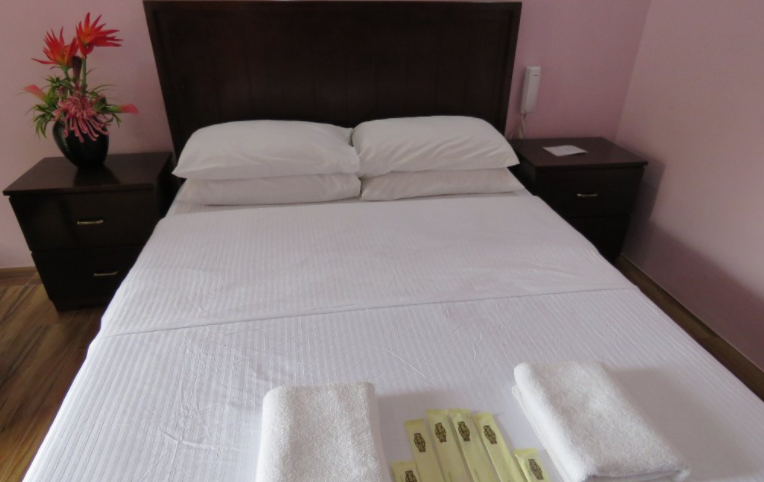
- Vice President Jejomar Binay of Cabagan, Isabela - politician
- Freddie Aguilar of Sta. Maria, Isabela - singer/songwriter
- Marissa Sanchez of Ilagan, Isabela - com
- Angel Aldeguer Guirado of Ilagan, Isabela - Azkals Ph Football athlete
- Jose Carlo Escalambre - NCCA player
- The Gollayan Sisters - Showtime winners
- Ma. Luisa Gonzales of Ilagan, Isabela - Beauty queen
- Edgardo Boy Vinarao of Echague, Isabela - film director
- Carito Villaroman - golf athlete
- Carmellette Villaroman - golf athlete
- Heherson Alvarez of Santiago City - politician
- Nestor Ochoa of Ilagan, Isabela - ambassador
- 4th Impact - winners from X Factor Uk
You May Also Like
No comments.
- Skip to content
- Jump to main navigation and login
Nav view search
- Quick Facts
- Vision, Mission, Mandate
- History & Culture
- Major Programs & Projects
- Awards Received
- Inaugural Speech
- City of Ilagan
- Delfin Albano
- Santa Maria
- Santo Tomas
- Benito Soliven
- Reina Mercedes
- San Mariano
- Santiago City
- San Agustin
- Cauayan City
- San Guillermo
- The Queen Province of the Philippines
- Why Invest in Isabela / Investment Priorities
- Economic Profile
- Business Opportunities
- Cost of Doing Business
- Schedule of Fair Market Values
- Local Revenue Code
- Local Investment and Incentive Code
- Local Policies and Regulations
- Investment and Competitiveness Profile
- LGU Directory
- Business Directory
- Business Advertisements
- Attractions &Tourist Destinations
- Photo Gallery
- Video Gallery
- How To Get Here
- Emergency Hotlines
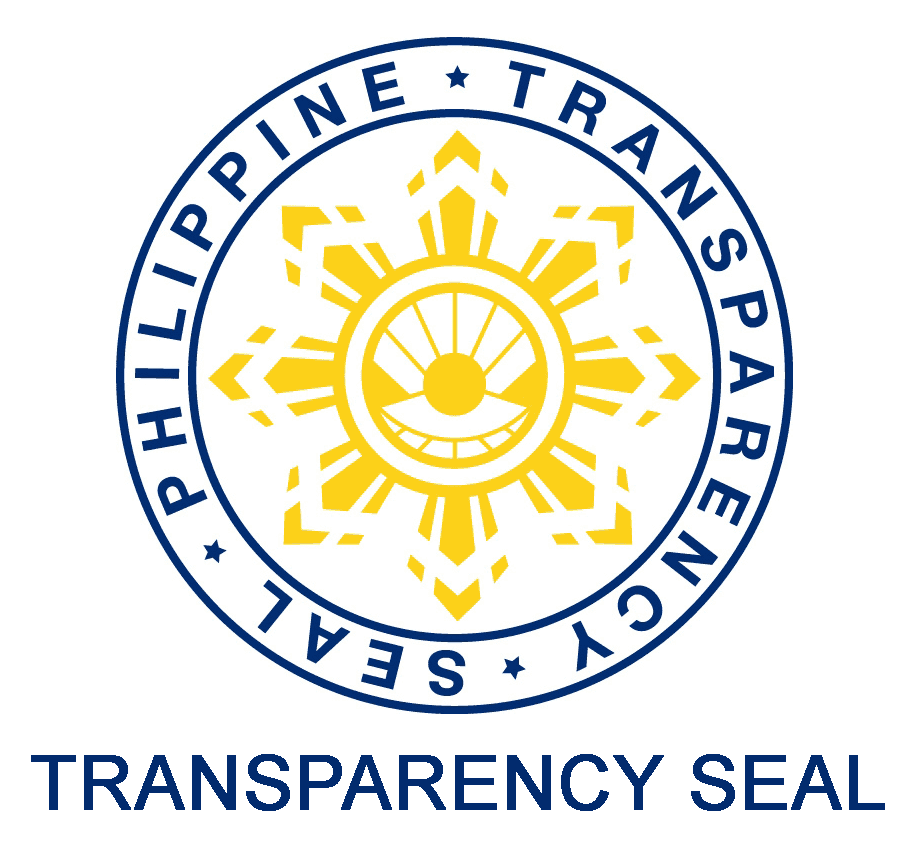
Calendar of Activities

Visitors Counter
- Archived Articles

- Tourist Destinations
- Tourist Destinations-B
Tourist Destinations
AGUINALDO SHRINE
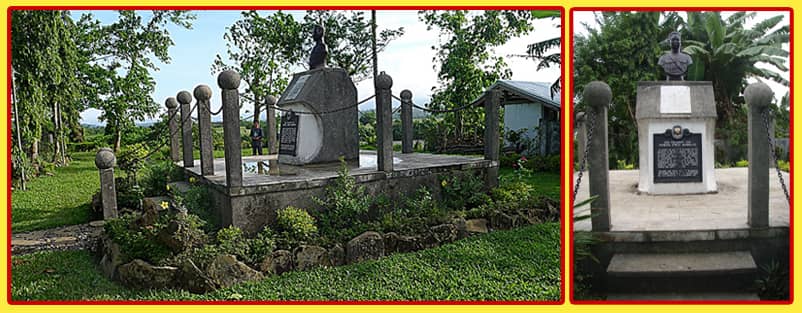
Although Isabela did not play a major role in the revolt against Spain, it is in Palanan that the final pages of the Philippines Revolution was written when the American forces led by Gen. Frederick Funston finally captured Gen. Emilio Aguinaldo in the area on March 23, 1901.
BONSAI FOREST

Dinapigue showcases a bonsai forest with plants ranging from one foot to 7 feet in height. The forest is astonishing – covering an estimated 5,000 hectares.
The historic Camp Samal was the site of the National Jamboree in 1977. Spanning at 23.50 hectares, elevated mass of rolling hills 500 feet above sea level overlooks the mighty Cagayan River, the Pinacanauan River, the town of Tumauini itself, the municipality of Delfin Albano, and the Sierra Mountain ranges.
CROCODILE SANCTUARY OF SAN MARIANO

San Mariano houses a gallery of spectacles ranging from its flora and fauna to the diverse river systems and waterfall formations.
The Philippine Crocodile, a critically endangered species, can be found throughout the length of the river and creeks of San Mariano. Mabuwaya foundation, and even the president of the famous clothing company Lacoste, Michel Lacoste, shows support for the famous Crocodile Sanctuary of San Mariano.
DIBULO FALLS
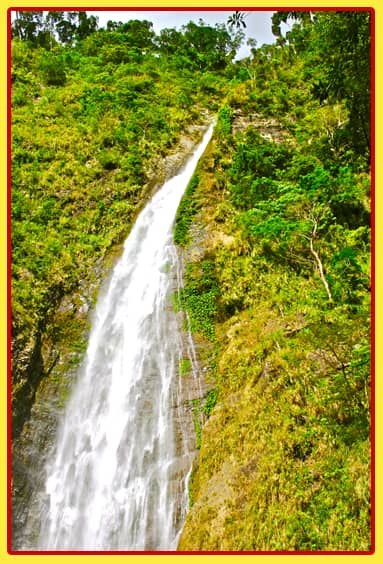
Dibulo falls is one of the most notable throughout the Sierra Madre mountain range. It is one of the attractions of Sierra Madre Nature Park.
DICOTCOTAN BEACH
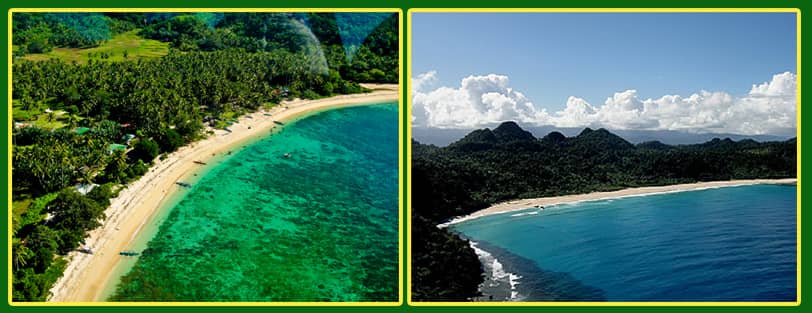
Dicotcotan Beach boasts of a three-kilometer long beach with coral reefs, sea grass beds and sandy shoreline that is fringed with a coastal forest and a village. There are regular sightings here of pointed nosed dolphins and hump back whales aside from the various species of fish and shellfish, and marine turtles that can be seen from the surface.
FUYOT SPRINGS NATIONAL PARK
Situated in the suburbs of Sta. Victoria, City of Ilagan, Fuyot Springs National Park nestles a multitude of attractions guaranteed to satisfy adventurers.
The park houses the Sta. Victoria Caves, which showcases more than 12 caves open for public spelunking. The caves feature formed lattices, stalactites, and stalagmites, a few of which have mineral deposits making them glimmer and shine when hit by light.
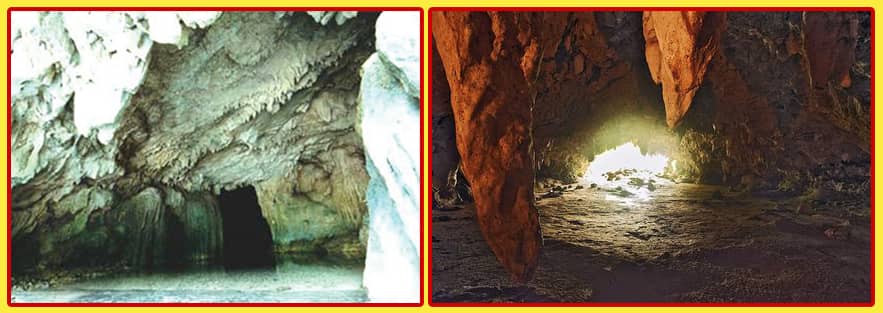
Also within the park is Pinzal Falls, reached by a treading a short trek from the park proper. Following the creek flowing from the falls, an adventurer will find a pathway of rocks and waterholes enough to excite an avid adventurer.
- Next >>

© 2023. The Official Website of the Province of Isabela

- TRAVEL GUIDES
- DESTINATIONS
- ADVENTURE TRIPS
- HOTELS & RESORTS
- FIND HOTELS WITH DISCOUNTED RATES!
ads_banners
Isabela tourist spots: visiting "balay na santiago" will transport you to santiago city's glorious past.

FOLLOW MY ADVENTURES ON YOUTUBE @PinoyAdventurista
4 comments :.
This is just 3 minutes away from my house. I should've met you. haha.

ganda ng buong bahay cute din nung harp

taga cagayan valley po ako pero hindi pa ako nakakapunta sa mga ganito sa amin :( So sad naman.

Oh my Oh my! Gusto ko na magpunta dito Don!
Looking for Budget Travel Guide Blogs, Hotel Reviews, and Sample DIY Itineraries? Welcome to Pinoy Adventurista, "Your Next Ultimate Adventure Starts Here!" Pinoy Adventurista is one of the Top Travel Blogs in the Philippines and the World. In 2013, he visited all the 81 provinces in the Philippines.

- VIGATTINDEALS
- VIGATTININSURANCE
- VIGATTINTRADE
- OTHER SITES
- DESTINATIONS
- TOURIST SPOTS
- RESTAURANTS
- FLORA AND FAUNA
- SPORTS AND RECREATION
- TOP 10 LIST
- TOURIST ATTRACTIONS
- VIGATTIN RADIO
- WELLNESS AND BEAUTY
- All Article
- Trending Articles

The City of Santiago
The city of Santiago is an independent city in the province of Isabela, Philippines. Santiago is situated 79 kilometers south of Ilagan City, the provincial capital city, and about 326 kilometers North of Metro Manila. The city sits on a vast area of predominantly flat and fertile land in the Cagayan Valley, surrounded by the Caraballo Mountains to the south, the Great Sierra Madre to the east and the Cordillera Mountain Range to the west.
The origin of Santiago City can be drawn from the first native settlement discovered by the early Spanish missionaries at the bank of the old Carig River (now Diadi River) from which its original name, Carig, was derived. The earliest inhabitants were the Gaddangs and the Ibanags. When the Spanish settled in, the city was named a Pueblo of Santiago Apostol de Carig, with Santiago as the Spanish name of Saint James the Apostle. In the early 1950s, the Municipal President Vicente Carreon changed the name to simply Santiago.
Santiago remained a municipality for 84 years. Santiago was originally a part of the province Cagayan (comprising the whole Cagayan Valley region), which was reorganized as a political subdivision in 1583 with Nueva Segovia as its capital. On May 1, 1856, when the Province of Isabela was carved out by a
Royal Decree, Santiago was among the towns relinquished to the newly created province. The first five barrios after the Cadastral survey in 1927 were Patul, Batal, Nabbuan, Buenavista and Dubinan.
It was said that there were only about three Filipino-owned sari-sari stores in Santiago in 1917. The settlers acquired most of their merchandise and other provisions from Chinese traders in Echague, the landing zone for products intended for Santiago and other towns, owing to its proximity to the Cagayan River.
It was when the Villa-Verde Trail was opened when things were set in motion. It facilitated the entry of immigrants from various provinces in Luzon to the Cagayan Valley and Santiago absorbed a sizable share of these travelers. The new route served as an impetus for growth and introduced new technologies and business opportunities.
Santiago survived through world wars, although badly damaged, and from then on developed to become the leading commercial and industrial city in Cagayan Valley.
In 1942, occupied by the Japanese forces entered in the town of Santiago.
In 1945, founded to the liberation in the town of Santiago province of Isabela beginning the Filipino soldiers of the 1st, 2nd, 11th, 12th, 13th and 15th Infantry Division and the USAFIP-NL 11th Infantry Regiment of the Philippine Commonwealth Army, the 1st Infantry
Regiment of the Philippine Constabulary and the recognized guerrilla fighter unit against the Japanese Imperial forces under defeated during World War II.
On December 17, 1993, the bill converting Santiago into an independent component city was approved by the Lower House. On the following year, the Senate Committee on Local Government approved another public hearing dated February 23, 1994. Signing of Republic Act 7720. seated from the left; starting from the third seat is former Mayor Jose "Pempe" Miranda, President Fidel V. Ramos and House Speaker Jose De Venecia On May 5, 1994, by virtue or Republic Act 7720 signed by His Excellency, President Fidel V. Ramos, Santiago was pronounced as an independent component city, the first in the Cagayan Valley Region. This made Santiago, self-governing and autonomous city from the rule of the provincial governor. Republic Act 8528 repealed this statute transforming it back to a component city. It was not until December 29, 1999, when the Supreme Court contested the validity of the latter decision and favored Santiago to be once again an independent component city.
Santiago City is Cagayan Valley's pioneer city. It ushered more development not only in Isabela but in the whole region. It motivated other towns to grasp for more progress and to uplift the people's standard of living. The city is highly equipped with facilities in health, education and security, making it a first choice in terms of settlement.
Considered as the commercial and industrial Center of Region 2, several business enterprises, banking institutions, educational entities, as well as manufacturing companies are present in the city.
Some of the biggest companies that can be found in the city are Vista Land-Camella Isabela, ABS-CBN, GMA7, San Miguel Corp., Pepsi Cola, Purefoods, Digitel and PLDT. The National Food Authority also maintains its presence in the city, competing with local traders as a strategy to stabilize prices. Different car companies like Mitsubishi, Toyota, Nissan, Isuzu, Hyundai, General Motors, other car companies as well as Yamaha and Honda Motors maintain their presence in the city. Kia Motors and Ford Mazda are set to open their branches in this city soon.
Santiago also houses some of the biggest and highly equipped hospitals in the region. The University of La Salette Hospital is said to be the biggest having a capacity of at least 350 beds. De Vera's Medical Center, Callang General Hospital and Cagayan Valley Sanitarium are also equally equipped private hospitals. The Santiago City Emergency Hospital and Flores Hospital are now considered Medical Centers.
Agriculture, however, is still the main source of livelihood. The main crops are palay, corn, high value fruits and vegetables. The city is where imposing grain stations can be found, buying agricultural crops coming from Ifugao, Kalinga, Quirino, Nueva Viscaya, and parts of Isabela. These crops are later transported either to Nueva Ecija, Bulacan, Pangasinan or Batangas. In addition, the city's new product is Muscovado sugar. The city aims not only to sell this product locally but also to export the same. Rice mills are also present.
The City celebrates Pattaradday Festival or dubbed as Araw ng Santiago. Pattaradday is an Ibanag word which means unity. It celebrates the unity of the ethno-linguistic groups that have merged in the city to make it the melting pot of culture of Region II and contributed to the city’s progress and development-unity in action. It is celebrated every May 1- May 6 the founding anniversary of Santiago.
In 2007, The City was given a Presidential Award for the Most Child-Friendly City under the leadership of Mayor Navarro.
Did you know?
Santiago was formerly called Carig. It was formerly a barrio of Echague. The towns Cordon, Diffun, Saguday, San Mateo and Ramon were formerly its barrios. The first five barrios after the Cadastral survey in 1927 were Patul, Batal, Nabbuan, Buenavista and Dubinan. The area bounded by the Provincial road on the NW Carreon St on the SW Abauag St on the NE and the lot of the Methodist on the SE was the site of the first public school building before it became a market site.
The present site of the PNB was the site of the old municipal, sold to PNB during the administration of Mayor Andres Acosta for P1.00. The lot now occupied by the heirs of Santiago Lumidao fronting the NAWASA was formerly the old Spanish Cuartel. The present Dubinan School and North Central School sites were former cemetery sites.
The lime used in the construction of the church in Santiago was quarried from Potia, Mt. Province. The first rural bank in Northern Luzon is in Santiago. The La Salette Fathers headed by Fr. Conrad Blanchet arrived in Santiago on December 21, 1948. The first native Doctor of Medicine, Lawyer, CPA, Dr. of Dentistry, and Pharmacists are Dr. Pascual Fernandez, Atty. Domingo Maddumba, Lucas C. Taguinod, Dr. Jose C. Tumanut and Nenifa Carreon. Eustaquio Bayaua, reportedly a strong man, singly brought the bell up to the church tower thru the spiral stair of the old church. Pacifico Alvarez of Santiago became Division Superintendent of Schools. The long hike by the Boy Scouts was recorded by the La Salette Scouts in 1955 from Gamu to Manila under the leadership of Fr. John Pelissier, MS. No native was ever elected Mayor of Santiago since the Philippine became a Commonwealth. Santiago was liberated from the Japanese on June 13, 1945.
Must Do’s In The City
- Climb the Calvary Hills and the Chapel of Transfiguration. Located at Dariuk Hills in Barangay Balintocatoc, the place offers a pilgrimage venue for the Holy Week where life-sized Stations of the Cross are presented from the foot of the hill going up to the top where the Chapel of Transfiguration is located. Found also at the top of the hill is the tallest image of the Our Lady of La Salette facing the City proper. The Chapel offers pilgrims commanding silence befitting a place for worship, ecumenical masses and retreat. Picnic huts, greeneries and playgrounds are also available in the area;
- Visit the Balay na Santiago. The museum showcases a collection of the ethno-linguistic lifestyle of those who made Santiago City the melting pot of culture that is today. It shows a glimpse of the past customs and traditions that have united the multi-race Santiagueños. Balay na Santiago is located at the heart of the city along Turingan and Melegrito Streets in Barangay Calao West, Santiago City;
- Participate in the Pattaraday Festival. Santiago City’s founding anniversary festivity is celebrated every May 1-5 of the year through Pattaradday Festival. Pattaradday, an Ybanag term means unity. Ybanags are said to be the first settlers of the locality. The festival has already won Hall of Fame in the Search for Best Tourism Event in the Philippines conducted by the Association of Tourism Officers of the Philippines. It features the best of the best festivities participated in by many street dances from all over the country. It also features a unique gathering of the ethno-linguistic groups of the city;
- Celebrate with Santiagueños on the Feast of St. James the Apostle. Celebrated every July 25 of the year is the Feast of Saint James the Apostle, the Patron Saint of the City. It features the life history of the patron saint as it saves the Christians against the Moros through Sarswela and the Grand Batalla of the Moro-Moro, a dance choreography depicting the battle; and
- Have a patupat, Santiago City’s native delicacy. It is a native rice cake cooked by soaking malagkit (sticky rice) wrapped in coconut leaves in a boiling juice of sugarcane for hours. Other sugar cane products such as molasses or pulitipot, muscovado sugar, sinaklob, and sugarcane vinegar and wine are readily available.
List of hotels in Santiago city
- Hotel Amancio
- Morte Carlo hotel
- Gation Hotel
- Spring Garden
- Diocitas Hotel
- Greenview Lodge
Where to Buy (Malls)
- Xentro mall (Under construction)
- Savemore (Inside of Xentro Mall)
Where to Eat (Fast Food Chains And Restaurants)
- Jolibee Bayan
- Jolibee Shell (24 hours)
- MCdonalds (24 Hours)
- Chowking Maharlika (24 Hours)
- Chowking (Santiago Bayan)
- Mang Inasal
- Goldilocks (UnderConstruction)
- Lot'sa Pizza
- Big Brother
- Genaros Bar and grill
- Steak house
- Blends and bites
- Bamboo Grill
How to Get To Santiago City
Santiago City is situated in the Province of Isabela at about 79 kilometers south of Ilagan, the Provincial Capital of Isabela and is located at about 326 kilometers north of Manila. It is about six hours drive from Manila. Public vehicle is available 24 hours in Baliwag Transit, Victory Liner, Florida Bus Line, and Nelbusco Bus Companies in Manila.
Likewise, Dalin, Royal Eagle and Dagupan Bus Line going to the City of Tuguegarao pass through the city of Santiago. It is an eight-hour drive.
By air, Cebu Pacific, Zest Airline, and Air Philippines are available flying Manila to Tuguegarao. Bus companies such as Baliwag Transit, Victory Liner, Florida Bus Line, Nelbusco, Dalin, Royal Eagle, and Dagupan Bus are available in Tuguegarao City bound for Santiago. Vans for hire are also available.
- http://en.wikipedia.org/wiki/Santiago,_Philippines
- http://www.lcp.org.ph/get_cf_detailed.php?id=5
About Us | Privacy Policy | Contribute Vigattintourism © 2024
Vigattin Tourism
A travel & food blog
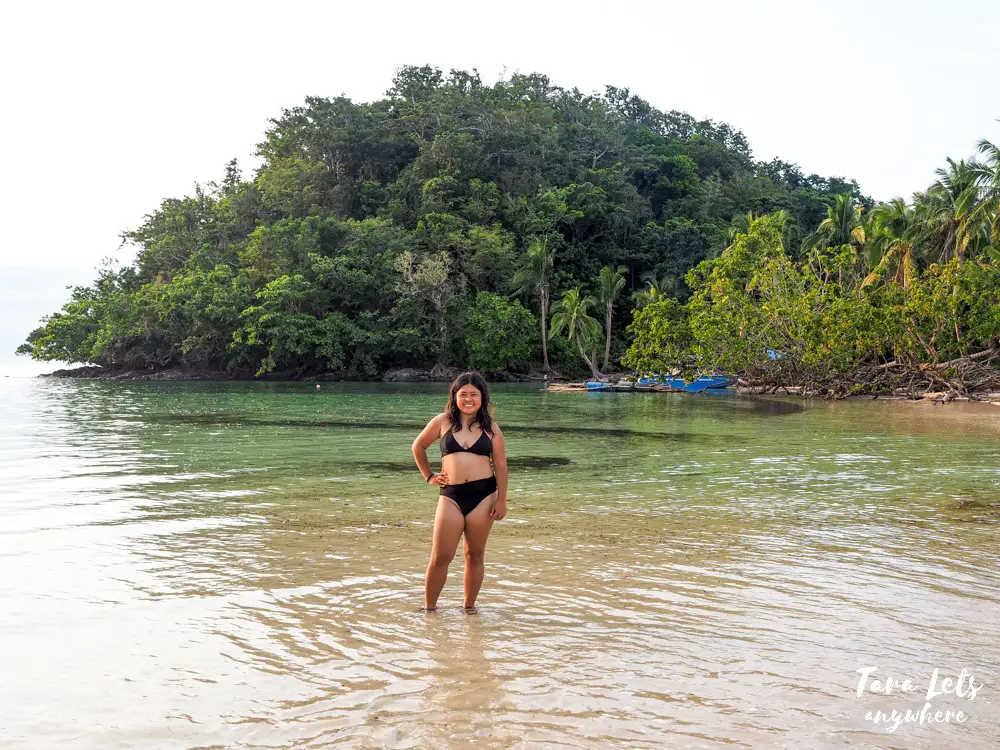
Backpacking Isabela: DIY Guide + 5 Days Itinerary
If you’re a backpacker like us, I’m sure you’re also dreaming of setting foot in Isabela Province. You’ve heard of Blue Lagoon and Honeymoon Island (a natural heart-shaped island in the region). Here’s a 5 days itinerary to Isabel Province!
I booked a joiner tour for this trip, so the organizer took care of the arrangements including itinerary, land & boat transfer and accommodation. Everything in this guide is based on our trip.
Take note that this itinerary covers the coastal area of Isabela Province. Other parts of Isabela including Santiago City are more accessible.
Please enable JavaScript

Manila to Cauayan:
Or manila to tuguegarao:, contact info:, via private transport, how to get around, day 1 – arrival in palanan, day 2 – palanan and side trip to dumagat village, day 3 – maconacon and divilacan, day 4 – dinapigue, day 5 – side trip to dipaculao and baler, final thoughts about the trip, where to stay, budget and expenses, what to read next:, how to get here.
As of our visit ( May 2019 ), roads that will provide easy access to the coastal area in Isabela are still ongoing construction. Nonetheless, you have several options to get here.
Via public transport
- By land: Take a bus to Santiago City, Isabela (8 hours). From Santiago City, take a bus or van to Cauayan (about 1 hour). OR: Take an overnight bus via First Class Victory Liner direct to Cauayan (9 hours).
- By air: Take a local flight via Cebu Pacific from Manila to Cauayan Airport.
- Once in Cauyan, take a 6-seater Cyclone Cessna plane to Palanan, Isabela (30-35 minutes). Airfare & miscellaneous fees is about P3000 per person or depending on weight of baggage.
- By land : Take a bus via Sleeper Florida Liner to Tuguegarao (12 hours).
- By air : Take a local flight via Cebu Pacific or PAL to Tuguegarao Airport.
- Once in Tuguegarao, take a WCC or NorthSky plane to Palanan.
From the town proper in Palanan, make your way to your selected accommodation.
- Ms Luz Bernardo Mendez, Cyclone Airways Cauayan: 0936 446 4979
- Ms Elda dela Pena, WCC Airways Tuguegarao: 0966 908 8704
- Mr Noel Cabrera, Northsky Airways Tuguegarao: 0905 332 1073
If you’re in a private van, you can take a boat from various ports (Dingalan, Baler or Disalag in Aurora) to Palanan, Isabela. From there, take a private boat to your accommodation.
What we did is drive until Disalag (about 10 hours) and take a boat to Bilay Makadawi Resort along Dicotcotan Beach (6 hours).
You can charter a private boat to tour around Palanan, Divilacan and Maconacon.
Our accommodation (Bilay Makadawi Beach Resort) took care of boat transfer from mainland to Palanan. We used the same boat service to explore the other parts of Isabela.
5 Days Itinerary to Isabela
Here’s a sample 5 days itinerary to Isabela. Please take it as a rough guide only.
Gala PH organized this trip and created the itinerary, which I’ve changed to reflect the places we were actually able to visit given a limited time frame.
It took us a while to arrive in Palanan since we did not take the private plane, but instead rode a boat for around 5-6 hours.
We arrived in Bilay Makadawi Beach Resort in Dicotcotan Beach. I really love this place. It’s rustic and homey but it was obviously given a lot of thought so it didn’t really feel like we were staying in a “simple” accommodation.
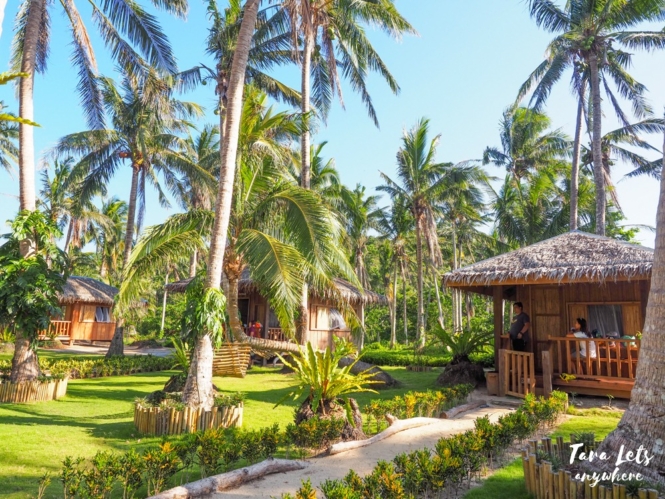
We spent the day resting. I also swam in the beach front which has crystal-clear water (no kidding) and then later on joined the others at the dipping pool in the resort. My friend Peng who went on the trip went to a snorkeling area nearby.
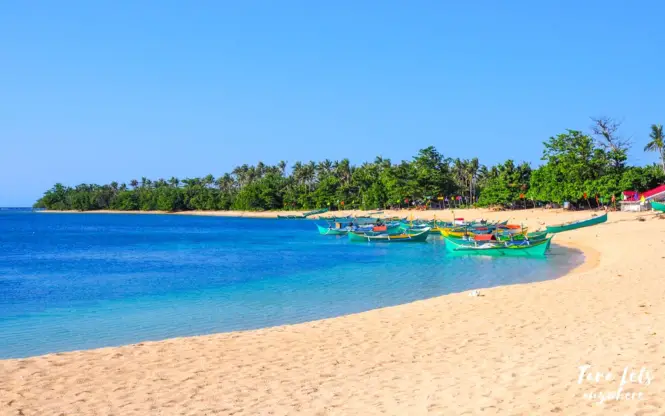
It was wonderful and I would like to go back here again.
From the resort, we took the same boat to explore other parts of Isabela.
Our first destination is Culasi Sandbar and Estuary and Sabang Mangrove Boulevard. These are just ordinary and for me can be skipped entirely.
Then we went to the town to register at the tourism office and explore the town attractions. One notable attraction is Aguinaldo Shrine, which is where Gen. Emilio Aguinaldo made his last stand.
Check our post on the Best Attractions in Palanan (Isabela) .
From the town, we rode a tricycle for 15-20 minutes to reach the Blue Lagoon.
Blue Lagoon is my favorite place in our trip. Seriously, it’s the subject of my dreams. This mysterious lagoon has an unknown depth, although presence of fishes suggests that it’s linked to the sea. (It also reminds me of my precious trip at Muna Island in Southeast Sulawesi where you can find several clear lagoons in the town.)
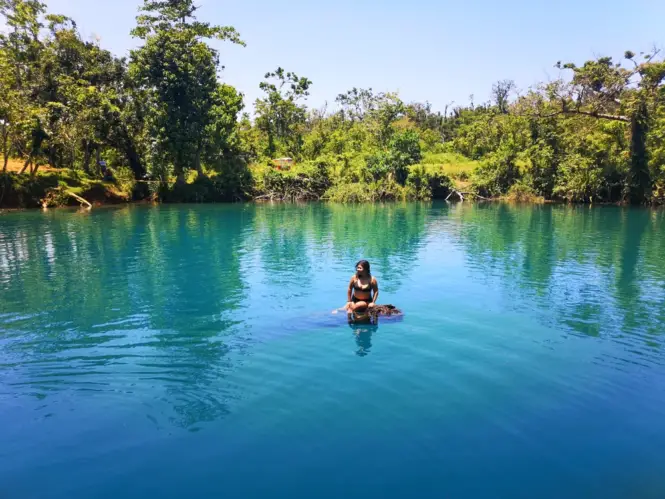
We arrived a little early in our resort. So we walked for 30 minutes to the nearby Dumagat Village home to the Dumagat tribe. The Dumagat were very welcoming and we took pictures with them! The village is located along Diago Beach. We walked from the beach to Dicotcotan Lighthouse for the sunset.
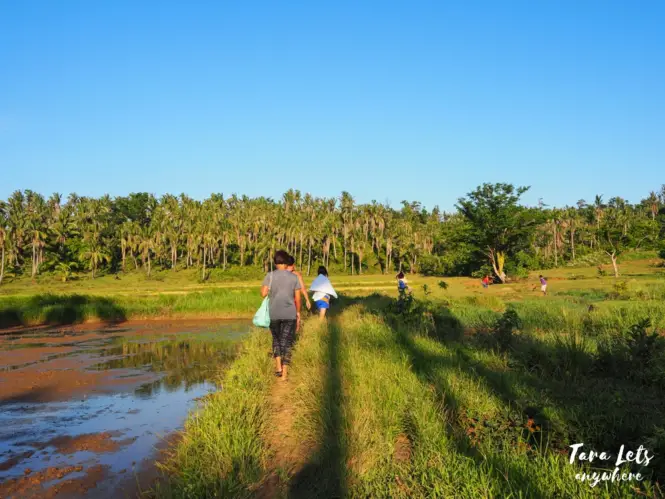
We rode the boat again to get to Maconacon. From the port, we rode tricycles to the town and then rented a private jeep that will take us for the tour.
Our first stop is Blos River. It’s considered one of the cleanest rivers in the country. We swam here but we were careful since there was a moderate river current. To be honest, I wasn’t really impressed since it looked like an ordinary river to me.
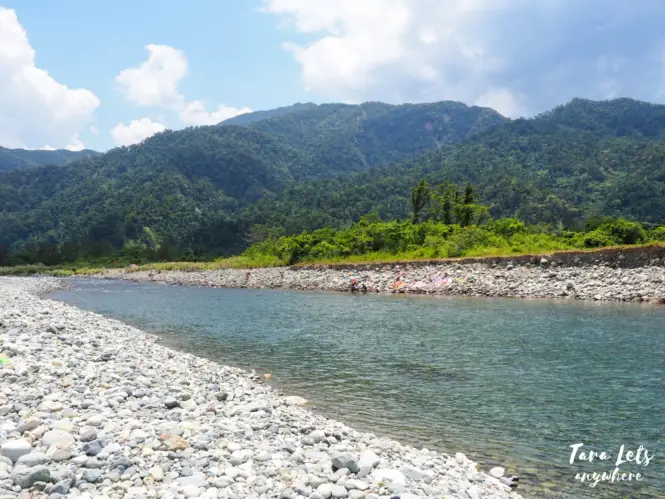
On the way back, we passed by Sumalag Beach, a pebble beach where you can find Dimanok rock formations. The rock formations are reminiscent of that in Calayan Island in Babuyan . Along the road, we also saw Sumalag Falls. This falls does not have a wide-enough basin for swimming so we just took pictures and left.
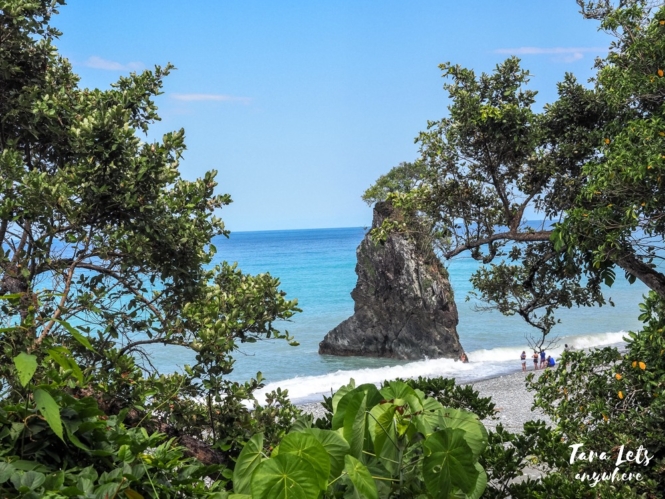
From there, we went back to our boat to visit Dipudo Island and Honeymoon Island. Honeymoon Island is a famous attraction in Isabela because it has a unique heart shape as seen from aerial view.
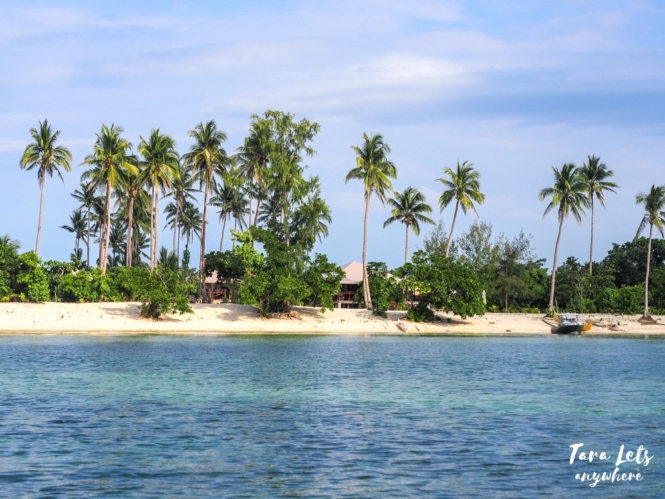
As of our visit, these islands are still under development and closed to the public but we were allowed to stay for a few minutes. It wasn’t enough time to enjoy a proper swim, but we were able to take pictures and at least I can finally tick that off my bucket list.
It was time for us to pack up. My heart was heavy leaving the resort.
We rode the boat back to the mainland. We went to Dinapigue and our van driver let us off at a nearby stream. From there, we walked to the jump-off/registration area of Dibulo Falls. Tricycles were also available but there we were a large group so not everyone was accommodation.
From the jump-off point, we trekked for about 15-20 minutes to reach the main drop.
Dibulo Falls stands at an impressive 100 meters high. It’s similar in features to Bomod-Ok Falls in Sagada. We swam in the freezing cold water and generally had a good time.
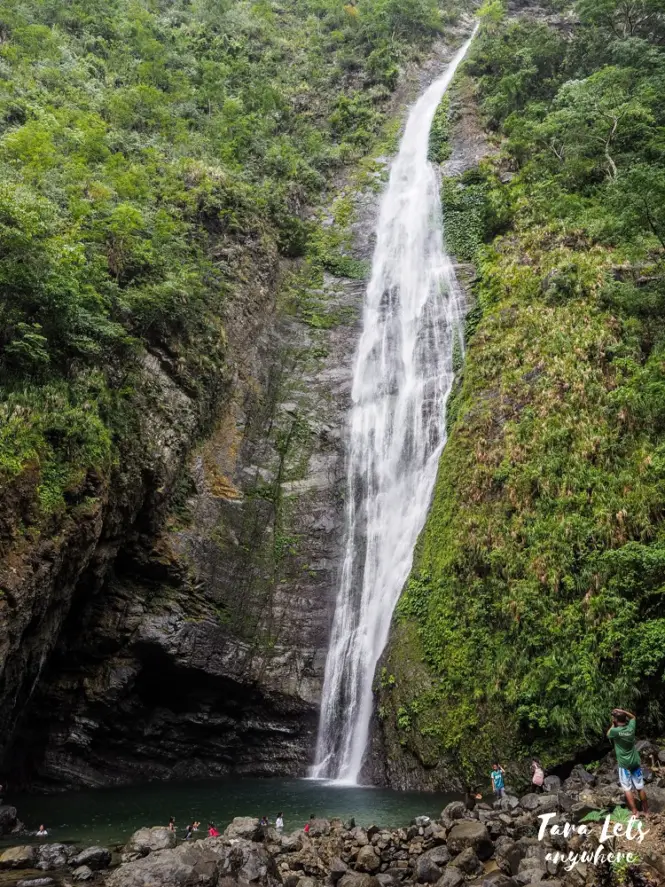
From there, we went to a resort in Casiguran (Aurora) where we would stay for the night.
We spent the last day on the road going home to Manila. We did a little side tour to Dipaculao and Baler to buy pasalubong.
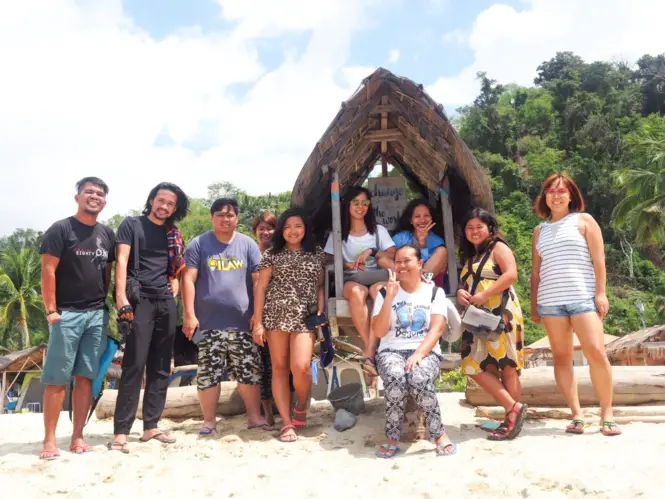
This is one of the best backpacking trips I’ve had. I’ve been wanting to visit the coastal area of Isabela Province for a long time but couldn’t due to lack of proper roads. So when I saw a joiner tour, I immediately booked a slot!
There are a lot of memorable places for me, including our accommodation (Bilay Makadawi Beach Resort), Dumagat Village, Blue Lagoon and Honeymoon Island.
Aside from these tourist spots, we saw a lot of beautiful places while traveling — rivers, carabaos bathing in streams and muds, rice fields and mountains. I’d like to mention this because sometimes we become too focused on reaching specific destinations that we forget to look around on our way there.
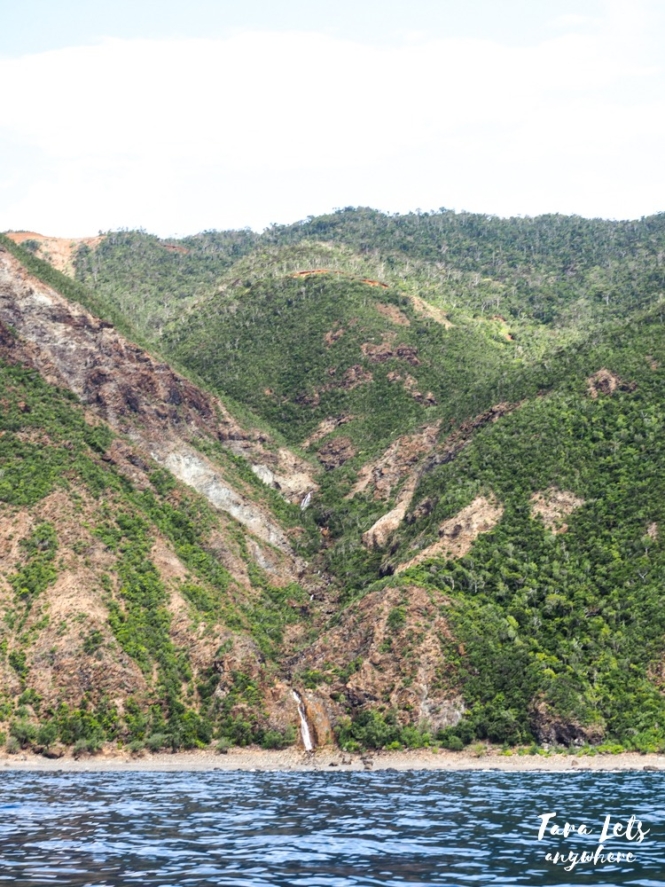
Overall, my trip to Isabela was fun and I’m happy to have finally set foot in this province.
For the duration of our stay in Isabela, we were booked at Bilay Makadwi Beach Resort.
This is a beach resort located along Dicotcotan Beach in Palanan, Isabela. There are cottages and treehouses you can book for overnight stay. The resort can also help you with your itinerary, transfers and tours.
Read about my stay at Bilay Makadawi Beach Resort .
Contact : Facebook | mobile: 0917 807 5857
Our budget per person is about P9000 (packaged tour + food and miscellaneous expenses).
Do you have anything to add to this travel guide to Isabela Province? Any specific place you’d like to recommend? Let us know in the comments below!
Planning a trip to Isabela Province? Here are our guides on Isabela:
- Best Tourist Spots in Isabela
- Best Tourist Spots in Palanan, Isabela
- Blue Lagoon
- Dibulo Falls
- Philippine Crocodile Conservation Center
Love backpacking?
- 5 Days itinerary in Isabela Province
Get discounts on your travels!

Enjoy discounts with KLOOK using our promo code: TARALETSANYWHERE

Katherine Cortes is a long-time backpacker and a freelance writer/editor. She likes beaches, snorkeling trips, and relaxing staycations (preferably with bath tubs!).

Leave a Reply Cancel reply
Your email address will not be published. Required fields are marked *
Save my name, email, and website in this browser for the next time I comment.
Notify me of follow-up comments by email.
Notify me of new posts by email.
This site uses Akismet to reduce spam. Learn how your comment data is processed .


COMMENTS
It is one of the best Santiago, Isabela tourist spots. Location/Jump-off: Santiago City; 20. San Pablo Church. It is considered the oldest church in Isabela. Built in 1624, the church features a six-layered bell tower which is the highest in Cagayan Valley. It is also one of the premium historical tourist spots in Isabela.
14. Dimasilong Ecotourism Park. (Photo by DOT - Region 2) One of the lesser-known Isabela tourist spots is the Dimasilong Ecotourism Park (simply referred to as Binombong by locals). The eco-park features crystal-clear streams, perfect for a dip especially during hot summer days.
Explore the St. James the Apostle Parish Church. Santiago Isabela is home to the beautiful St. James the Apostle Parish Church, and it is a must-visit attraction for anyone exploring the city. The church's stunning façade immediately catches your eye as you approach it. The intricate architectural details and intricate carvings tell ...
Tourist Spots in Santiago City. Start your journey in Santiago City, Isabela with the awe-inspiring Calvary Hills. These hills stretch out over 11 hectares, holding 14 life-sized Stations of the Cross that lead to a three-story-high Giant Cross. As you walk along the path, you'll experience the serene atmosphere of the location, which ...
The bus journey provides a seamless and comfortable mode of travel, giving you the chance to unwind and relish the excursion. Buses for Santiago City frequently leave from Pasay, providing a range of choices all day long. 3. Duration and Frequency. Prepare yourself for a journey that typically takes between 5 to 8 hours.
Absolutely one of the best tourist attractions in Isabela is the cascading beauty of Dibulo Falls. This hidden gem located in Dinapigue, Isabela is the tallest waterfall you can find in the province with a towering height of 100 meters. The giant white crystal clear waters cascading down the side of a majestic mountain are truly a magnificent ...
On May 1, 1856, when the Province of Isabela was carved out by a Royal Decree, Santiago was among the towns relinquished to the newly created province. The first five barrios after the Cadastral survey in 1927 were Patul, Batal, Nabbuan, Buenavista and Dubinan. It was said that there were only about three Filipino-owned sari-sari stores in ...
Arguably, Dibulo Falls in Dinapigue is the tallest waterfalls in the Province of Isabela with an approximate height of... 9. Bonsai No Sato Park. 2. Gardens. By jasonmC6289FJ. Amazing views and so quiet and peaceful. Highly recommend as a place to unwind for a few hours or longer. 10.
Amancio Farm Hotel. 1. Villa Diana Hotel & Cafe. 21. The Maximilian Hotel. 8. Palaisdaan Hotel and Restaurant. 7. Santiago City Tourism: Tripadvisor has 52 reviews of Santiago City Hotels, Attractions, and Restaurants making it your best Santiago City resource.
12. San Pablo Church. Visit one of the oldest churches in Isabela, built in the 17th century and located in the municipality of San Pablo. 13. Balay na Santiago. Explore this ancestral house turned museum in Santiago City, showcasing the rich history and culture of the province.
Santiago, Isabela Attractions - What to See and Explore. Santiago, Isabela offers many attractions and places to visit. Here are the most important ones: Balay ti Santiago, St. James Parish Compound. Below you will find a complete list of places worth visiting. 16°41'35"N • 121°33'7"E.
700-meter high cable car ride of Ilagan Sanctuary, Ilagan, Isabela. Photo by SinoPinas courtesy of the Department of Tourism. When you're visiting Isabela, make sure to stop by these tourist spots: Stay here: Zen Hotel Maharlika Highway, Villasis, Santiago. Zen Hotel is the first three-star hotel In Isabela and Cagayan.
When the trail was built, Santiago became the focal point of trade and its growth was faster than Echague and other towns of Isabela. Santiago was converted into a city after Republic Act 7720 was approved in a plebiscite held on May 5, 1994, becoming the first city in Cagayan Valley. Famous People from Santiago City Joseph S. Tan - Mayor
The Isabela Provincial Museum is located in an old Spanish building that used to be the provincial capitol. It showcases the rich cultural heritage of the province, including antique farming tools, traditional clothing, and local handicrafts. The Santiago City Museum is another must-see attraction for history lovers.
Isabela is the Philippines' biggest province in terms of land area occupying more than 1 million hectares of land. It is made of 34 municipalities and 3 cities located in northeastern part of Luzon: to the north is Cagayan; east by the Pacific ocean; south by the provinces of Aurora, Quirino & Nueva Vizcaya and west by the provinces of Ifugao, Mount Province and Kalinga.
Tourist Destinations . AGUINALDO SHRINE. Although Isabela did not play a major role in the revolt against Spain, it is in Palanan that the final pages of the Philippines Revolution was written when the American forces led by Gen. Frederick Funston finally captured Gen. Emilio Aguinaldo in the area on March 23, 1901.
Wilmer Resort Hotel And Restaurant. Purok 07, Santiago City, 3311. (078) 682-2188 / 5270 / 09175833353.
This is part of my 3-day trip to the provinces of Nueva Ecija, Nueva Vizcaya, Quirino and Isabela that happened last March 2-4, 2012.Join me as I re-visit the second largest province of the Philippines - Isabela.To read my other posts on Isabela, click here.: Map By: Wikipedia Visiting "Balay Na Santiago" will Transport you to Santiago City's Glorious Past
The city of Santiago is an independent city in the province of Isabela, Philippines. Santiago is situated 79 kilometers south of Ilagan City, the provincial capital city, and about 326 kilometers North of Metro Manila. The city sits on a vast area of predominantly flat and fertile land in the Cagayan Valley, surrounded by the Caraballo Mountains to the south, the Great Sierra Madre to the east ...
To make Isabela tour easier, here are the 10 best tourist spots in Isabela province: 1. Honeymoon Island. Photo source: Project Lupad. This place is perfect for a couple or a group of friends who love beach getaways. The Honeymoon Island is located at Divilacan, Isabela.
By land: Take a bus to Santiago City, Isabela (8 hours). From Santiago City, take a bus or van to Cauayan (about 1 hour). OR: Take an overnight bus via First Class Victory Liner direct to Cauayan (9 hours). ... Aside from these tourist spots, we saw a lot of beautiful places while traveling — rivers, carabaos bathing in streams and muds, rice ...
from $30/night. Villa Diana Hotel & Cafe. 21. The Maximilian Hotel. 8. Palaisdaan Hotel and Restaurant. 7. from $13/night. Santiago City Tourism: Tripadvisor has 52 reviews of Santiago City Hotels, Attractions, and Restaurants making it your best Santiago City resource.
Tourist Spots and Places to visit in Santiago City Isabela. Situated in the picturesque Cagayan Valley, the city boasts a diverse geographical landscape. Aside from being in the second largest province in the country, the city is characterized by approximately 80% flat or nearly level land in the northwestern, eastern, and western parts, while ...